SECTION FIVE:
The essence of hospitality is people welcoming people, represented in this panel with twenty-two portraits!
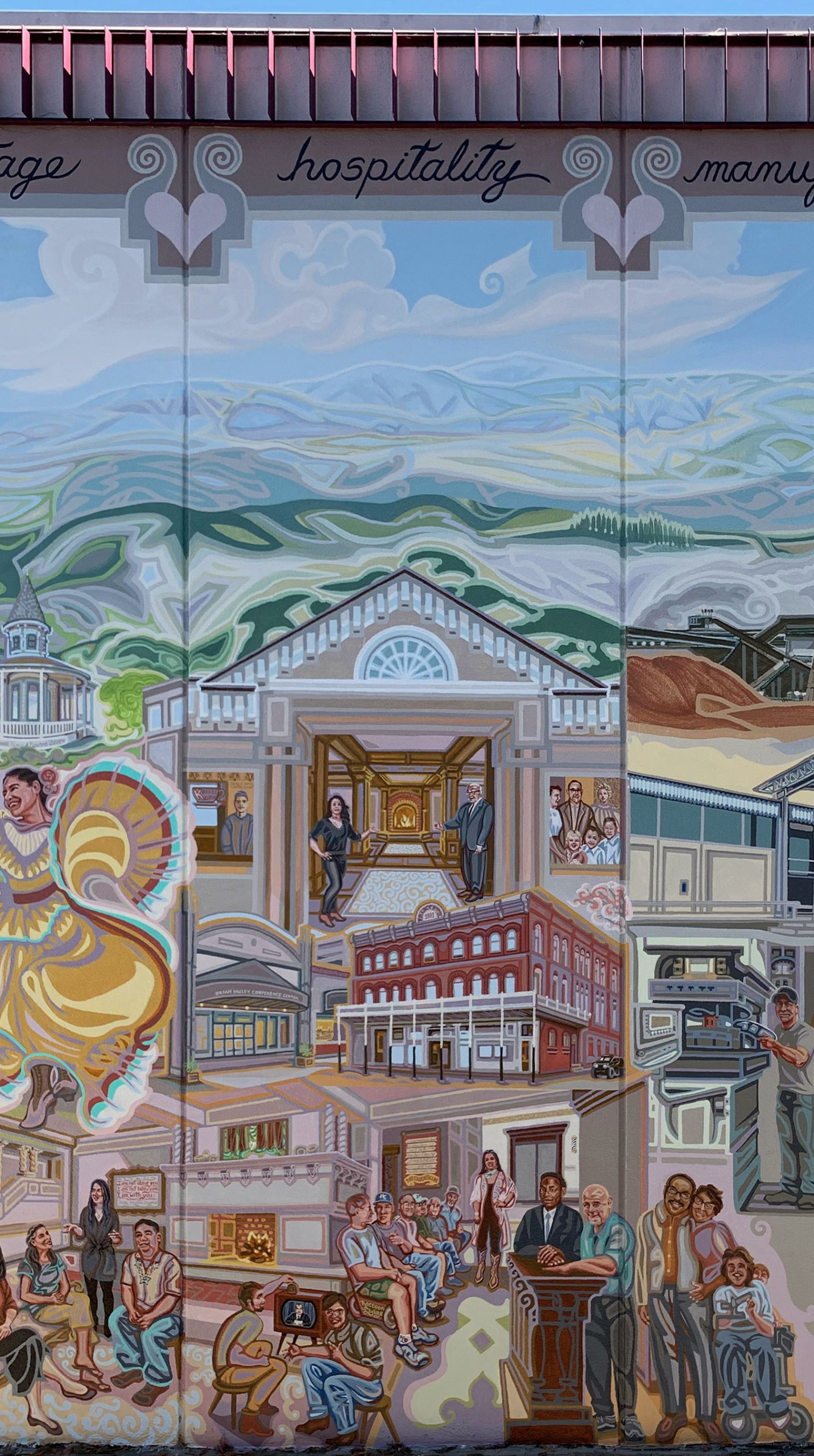
What will you find on this page?
- Palace Hotel
- “Mr. Ukiah”
- Who is that woman?
- Wong Lung and the Koffee Kupp
- Sandelin family
- A portrait of a building on its own wall
- That’s quite a party going on!
- Why is Nixon on TV??
- The Raccoon Lodge
- Two candidates for Supervisor
- Hal Perry and how a small California city found its better self
- Two icons: Big John and Martha
Four views of Ukiah’s beloved Palace Hotel set the stage.
The Palace Hotel
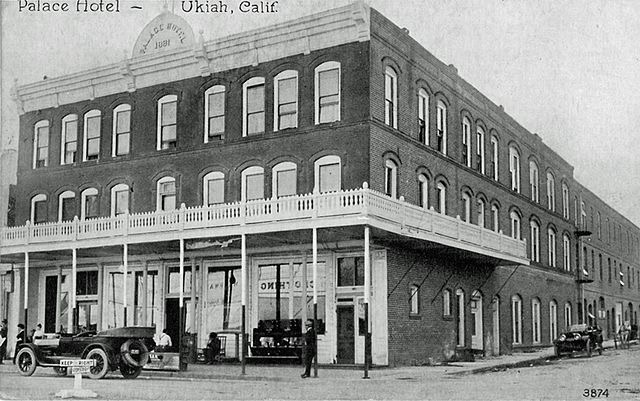

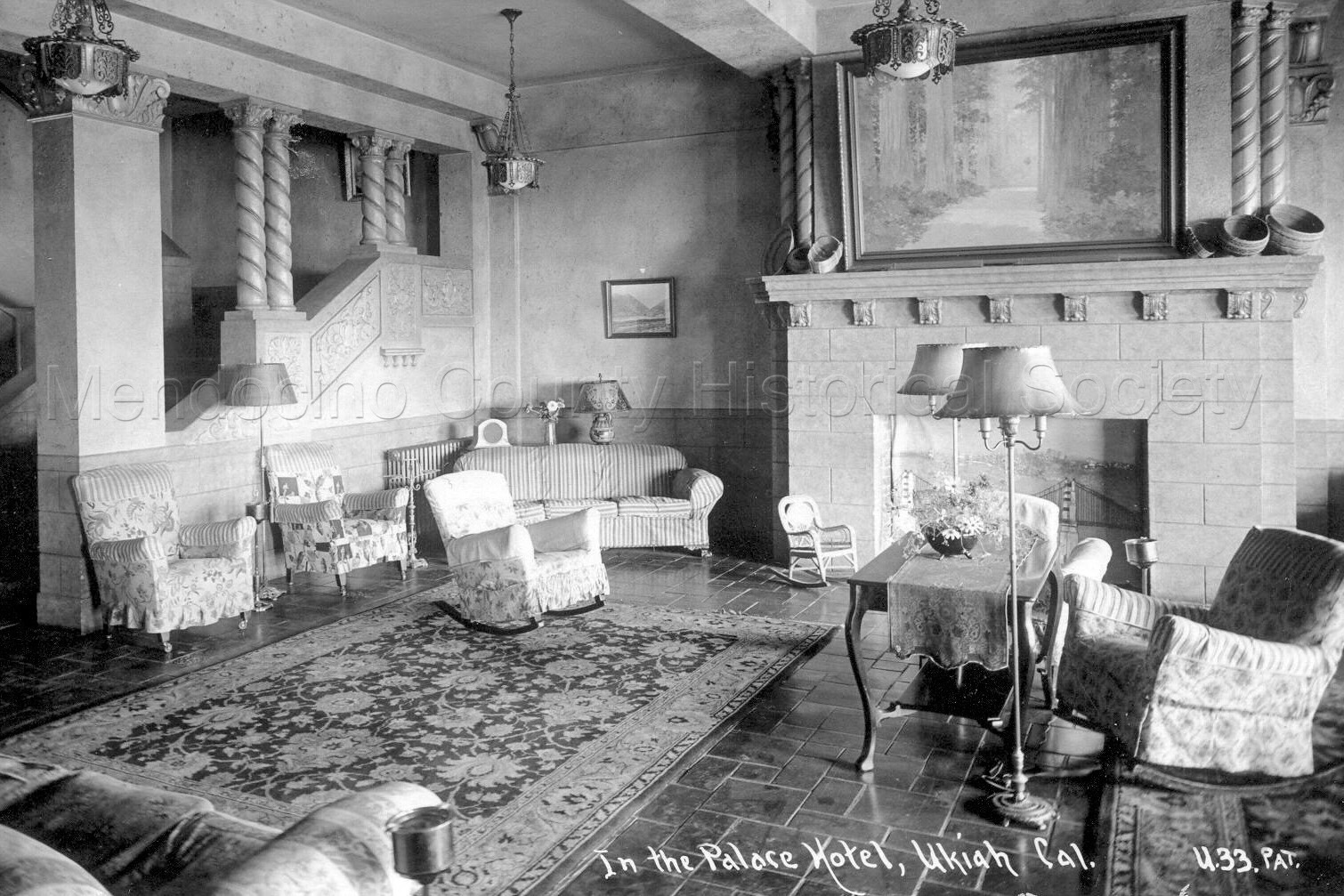
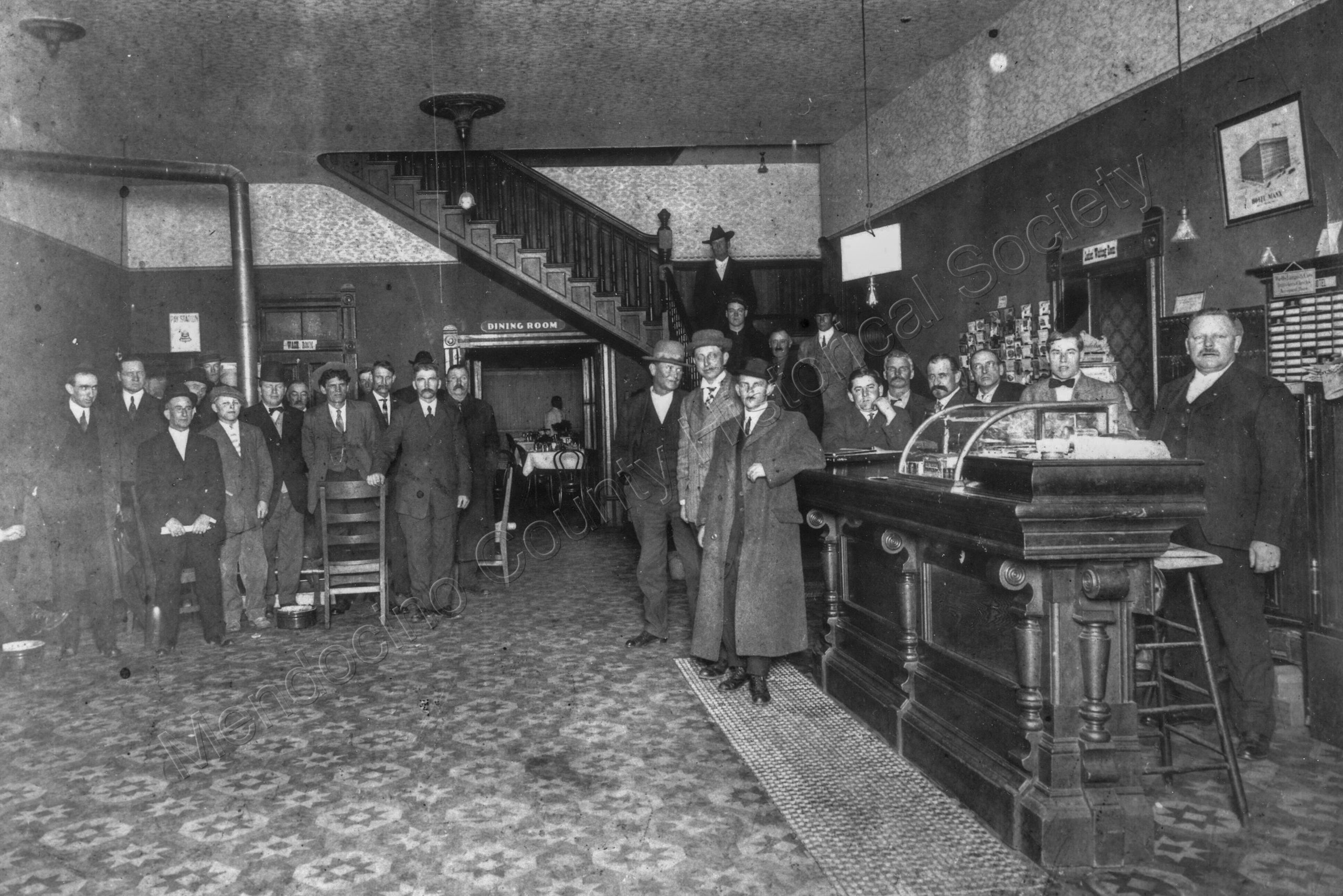
The Palace Hotel was built in 1891. By that time there was a vibrant Finnish community in Mendocino County. They were typically engaged in lodging and timber. As a respite from work, group saunas were popular, followed by white wine. In 1904 the Finnish immigrant Frank Sandelin moved with his family from the coast and began running the Palace. He appears in the photo above on the right, behind the lobby counter.
Mr. Ukiah
His son Walter took over the hotel in 1926, running it until 1966 and becoming so well known that he was called “Mr. Ukiah.” He had to be the man greeting the world into this comfortable, welcoming abode.
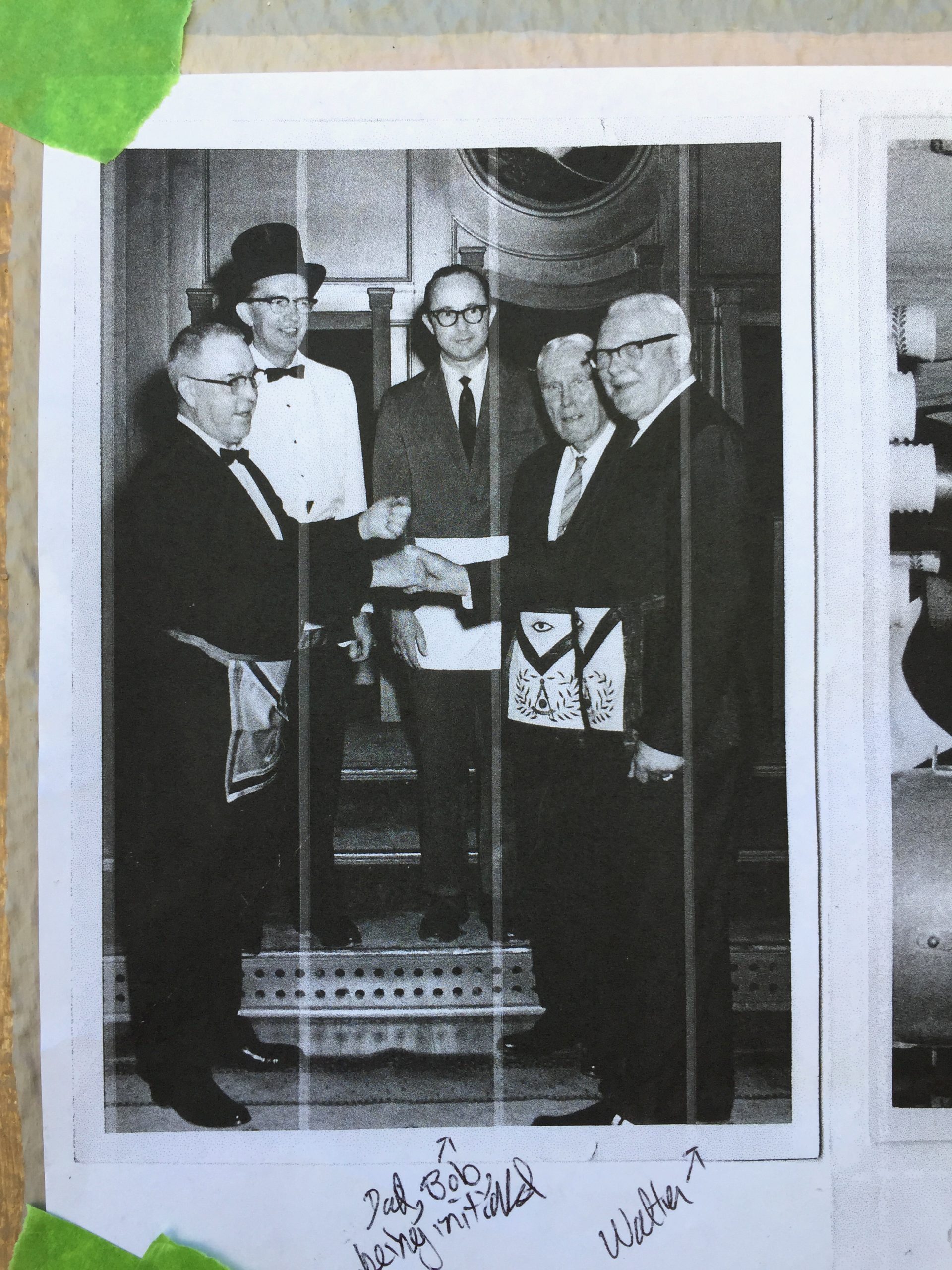
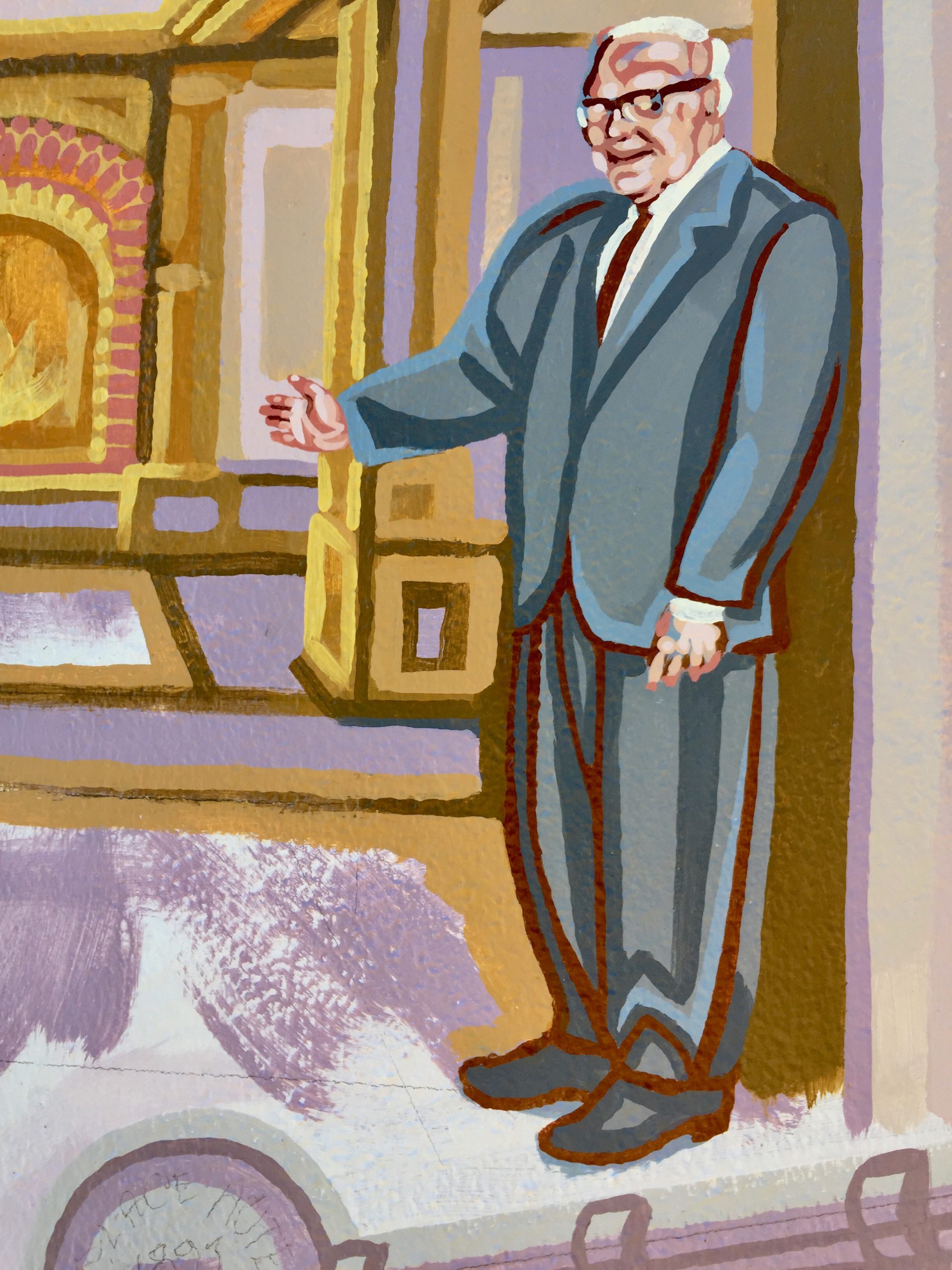
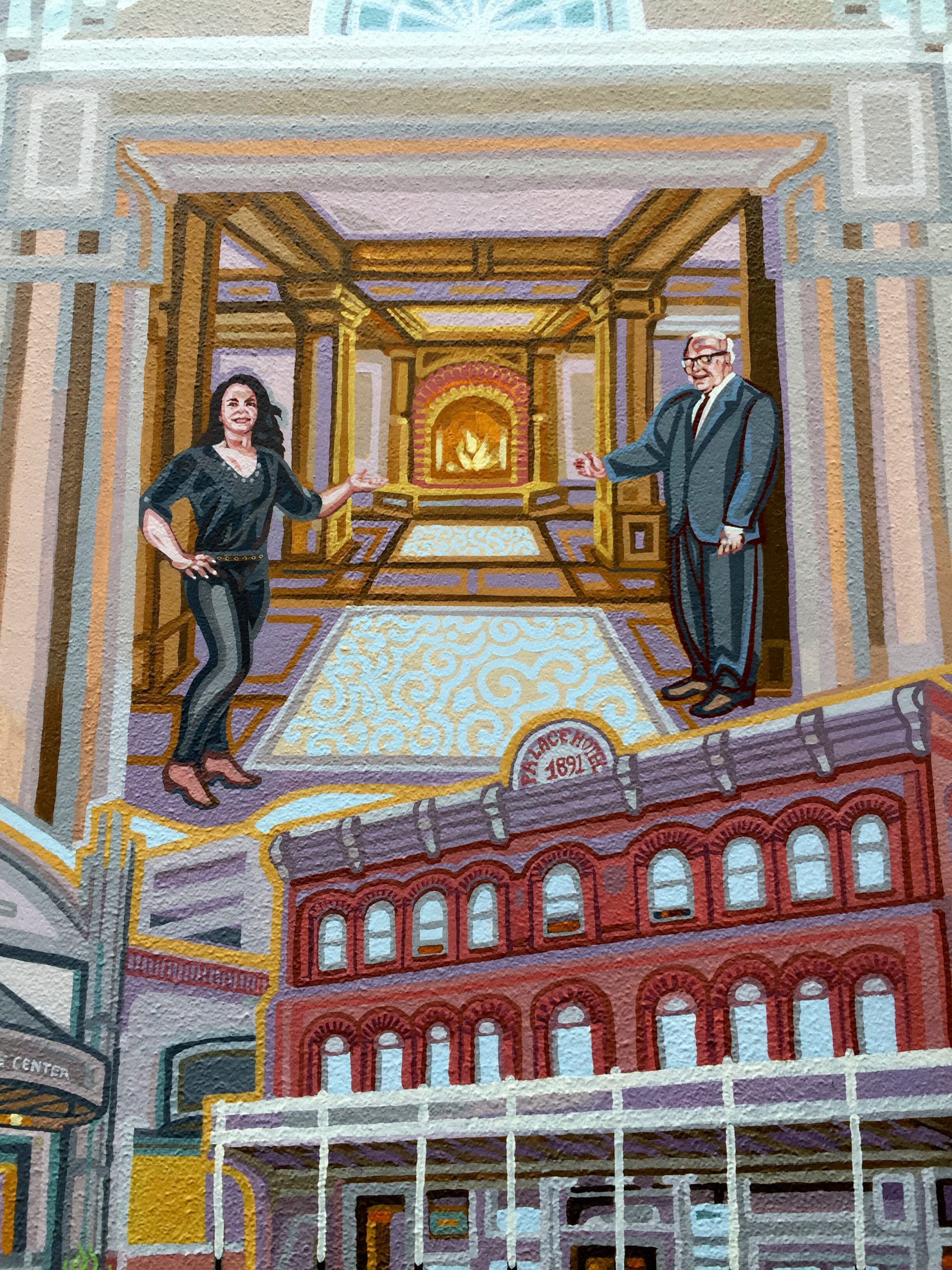
But who should the other figure be?
I wanted to contrast the historical figure of Walter with a contemporary woman proprietor. I perfect candidate was Eddie Palmerin of Eddie’s Cocina – Mexican Cuisine, just around the block.

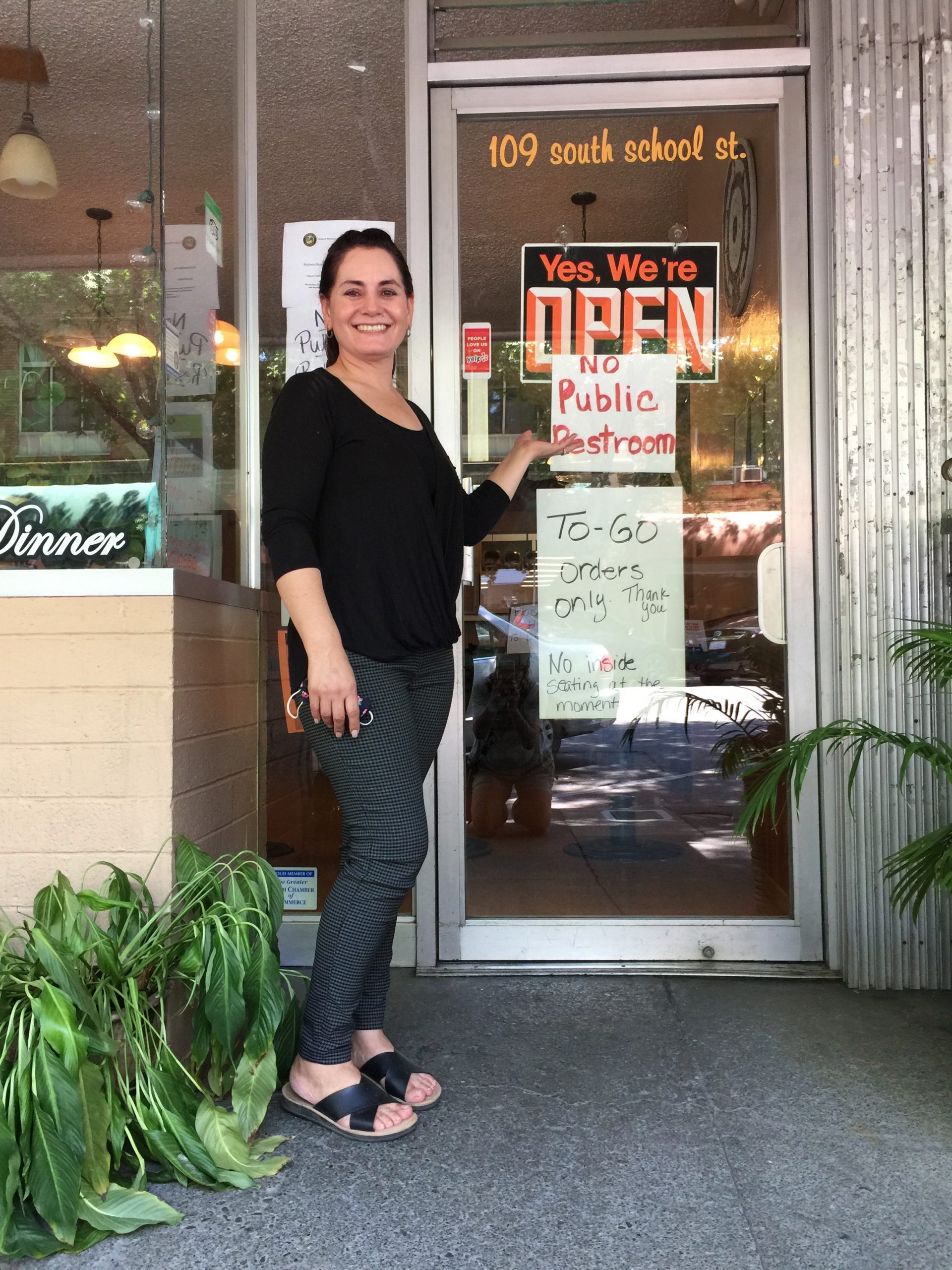
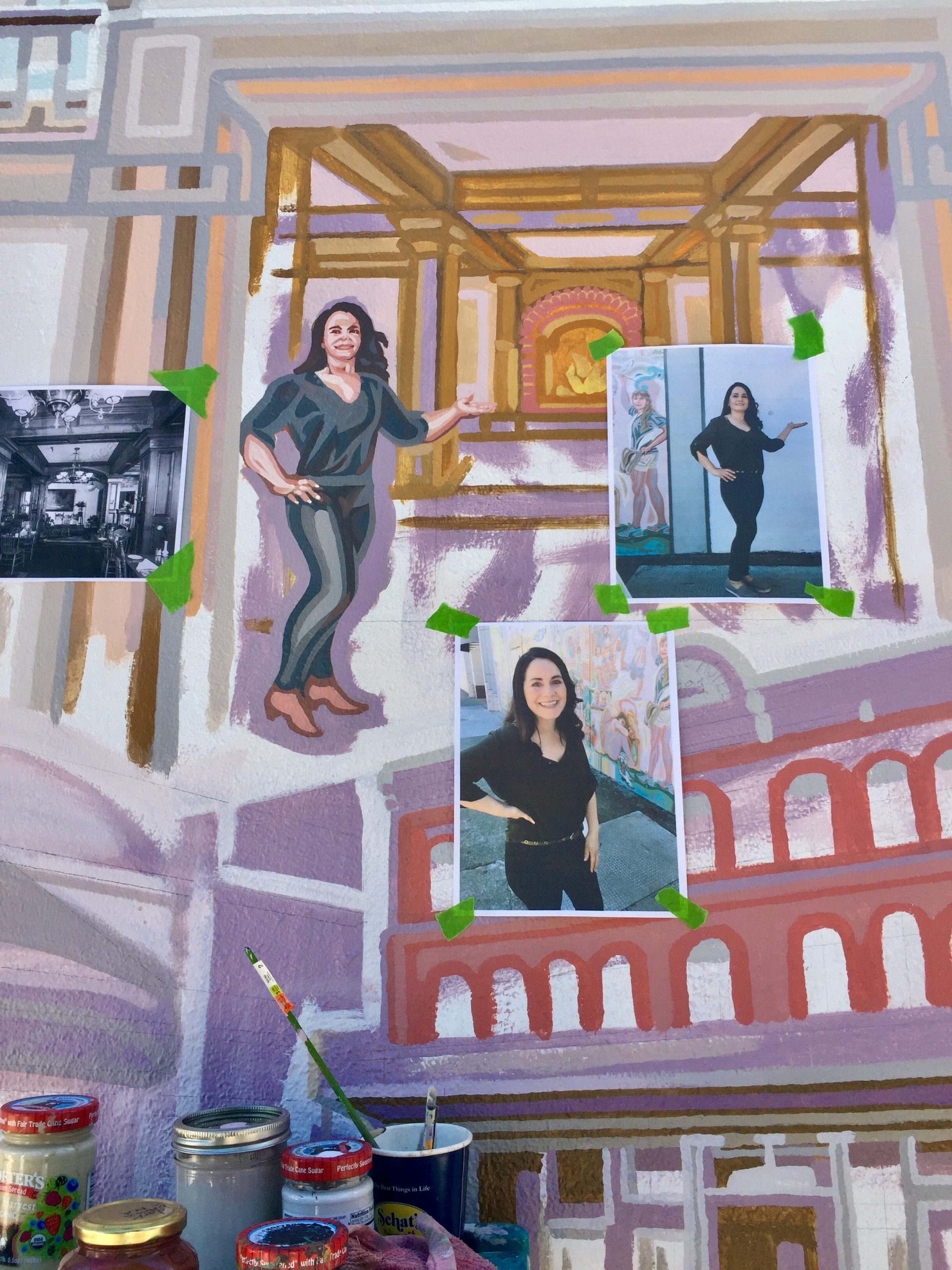
When she came to pose, she brought a work apron, but we both agreed she should ditch it because the mural needed to make clear that the woman isn’t always just the help!
The windows on either side of the welcoming scene provided the stage for more portraits.

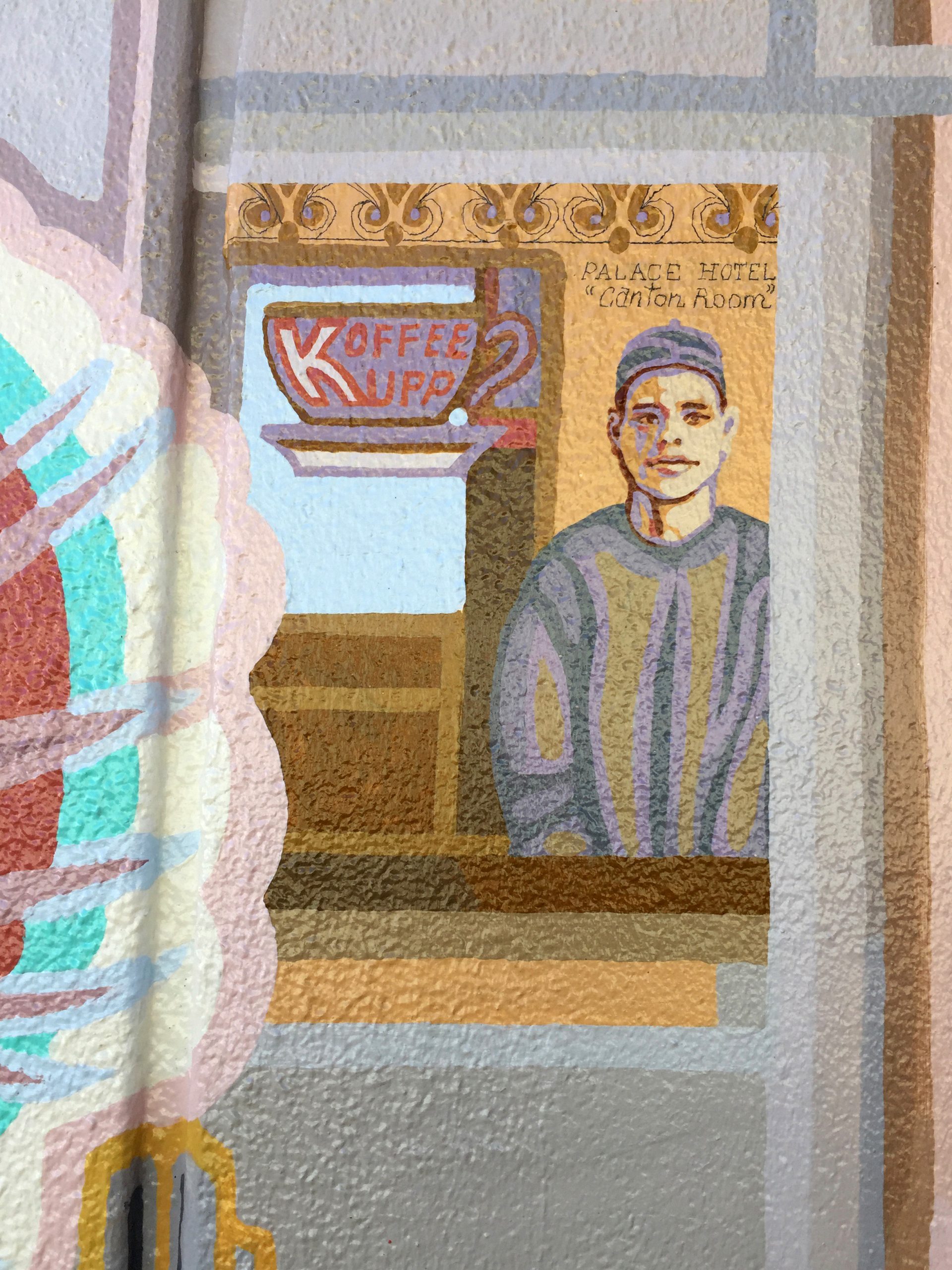
Wong Lung made his way to Ukiah from Hong Kong around 1892 and was hired in one of the places the Chinese could find work, a kitchen. That kitchen was at the Palace Hotel, where he rose through the ranks to become head chef, and where the banquet space was named the “Canton Room” in his honor. In 1926 he opened the popular Koffee Kupp in the hotel. He retired after fifty years, returning to his wife and family in Hong Kong.
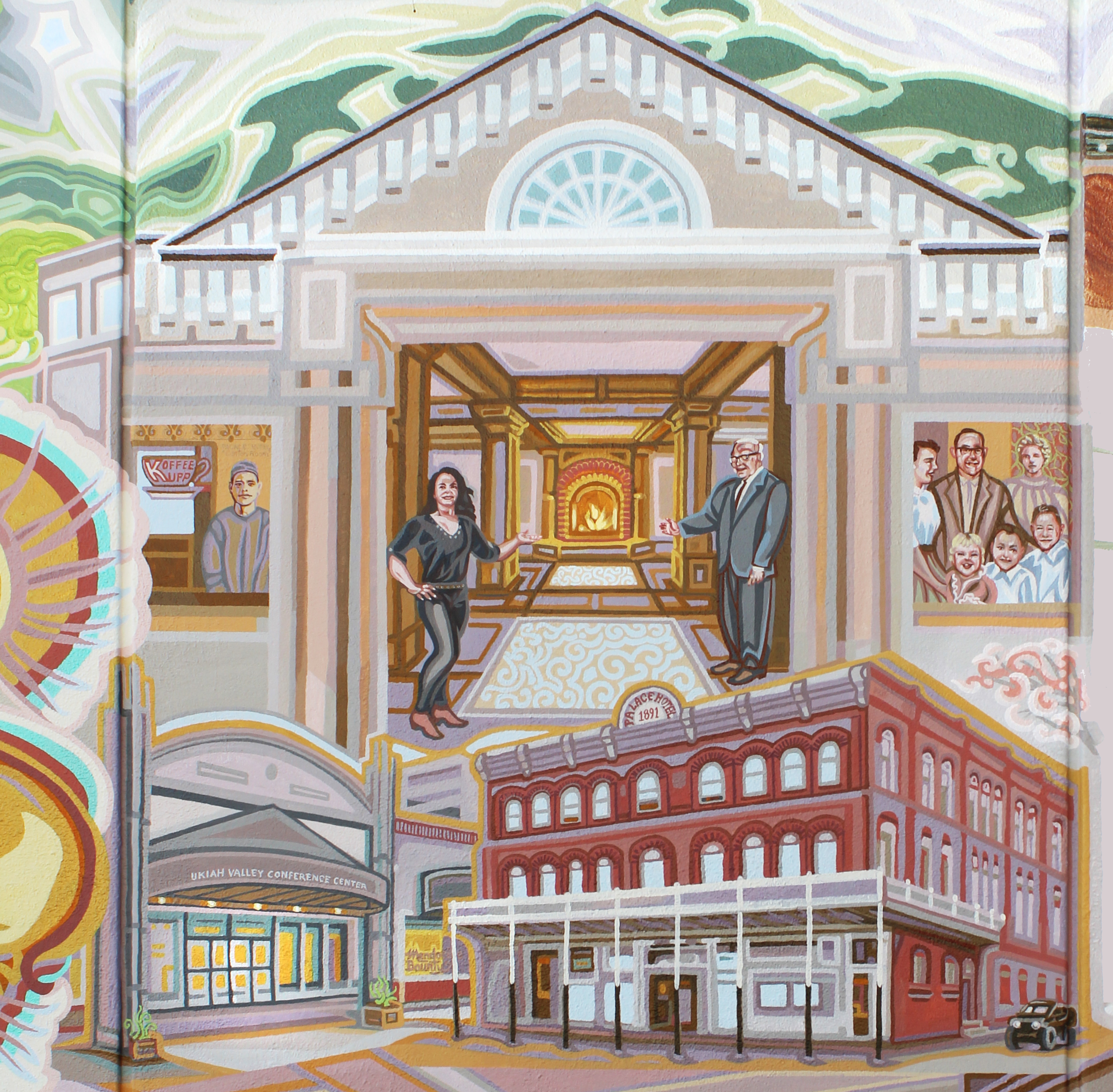
Sandelin family
In the window to the right, I painted six members of the Sandelin clan after meeting Walter’s grandson Roe, who shared their family history and photos. Notice the photos taped up on my work surface in the first picture below. The left-most photo is of Frank and Maria Christina Sandelin who took over the Palace Hotel in 1904. A mother of three, Maria also performed all of the room cleaning AND kitchen duties in those early years. Her son Walter (above) remembered her “working like hell.” I honored her by painting her portrait behind the happy family of her grandson Bob (second photo below).

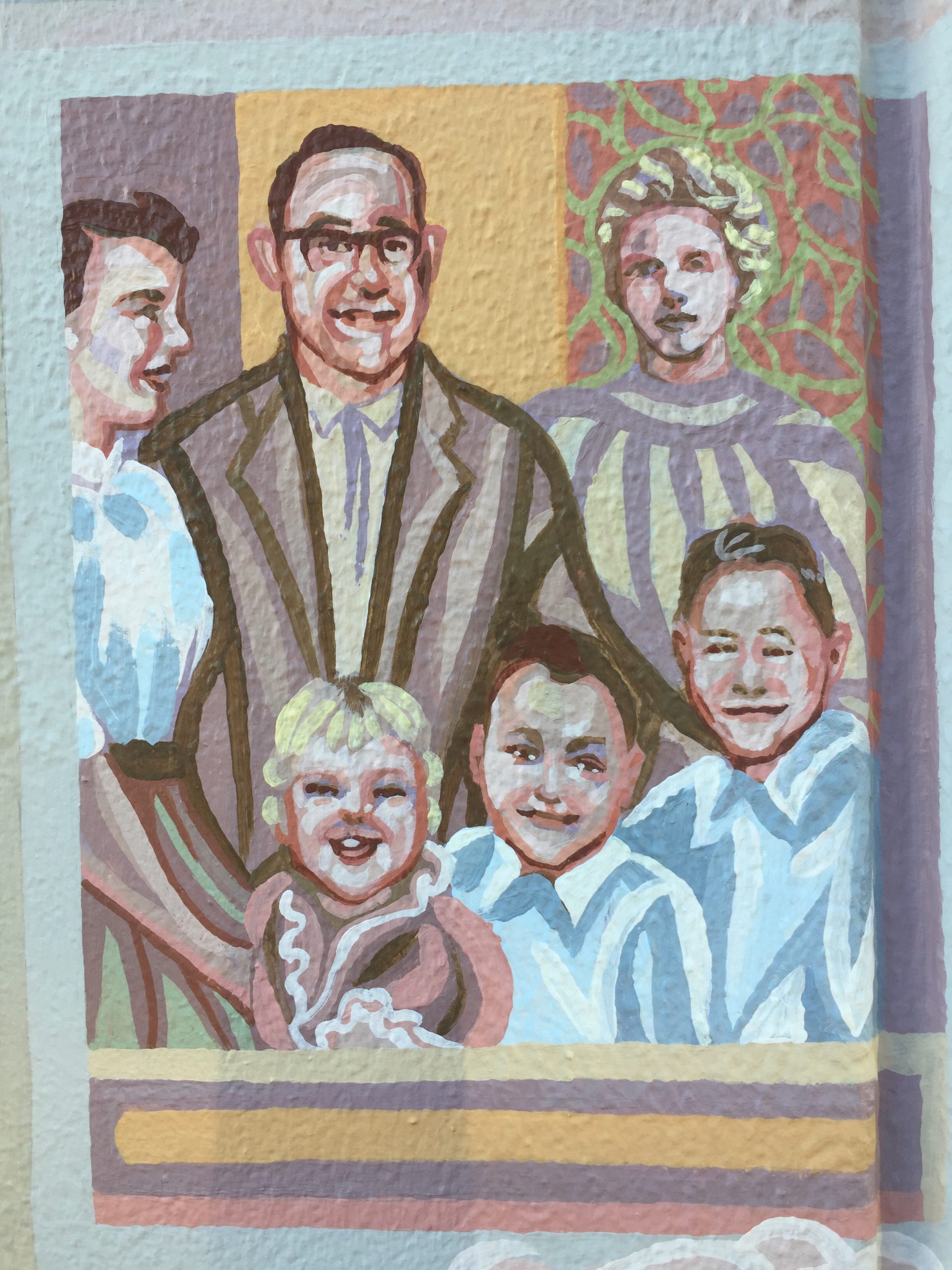
Bob worked behind the scenes for years. He spearheaded the conversion of a number of the hotel’s rooms into permanent residences, including for his Aunt Stella (see panel 20 heritage). His goal as a father was to love his kids immensely and equally, rejecting the poison of favoritism. According to his son Roe, he succeeded admirably.
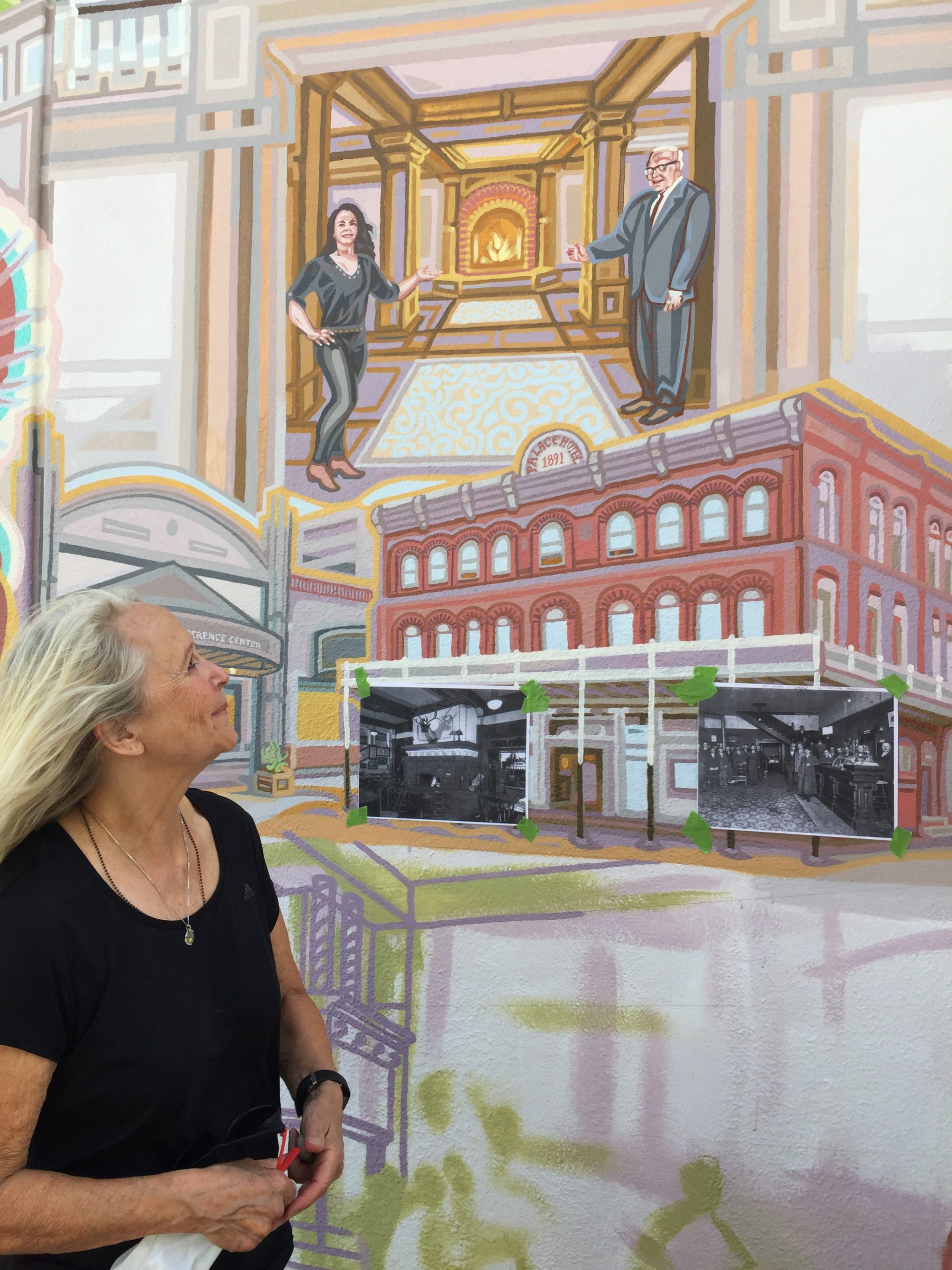
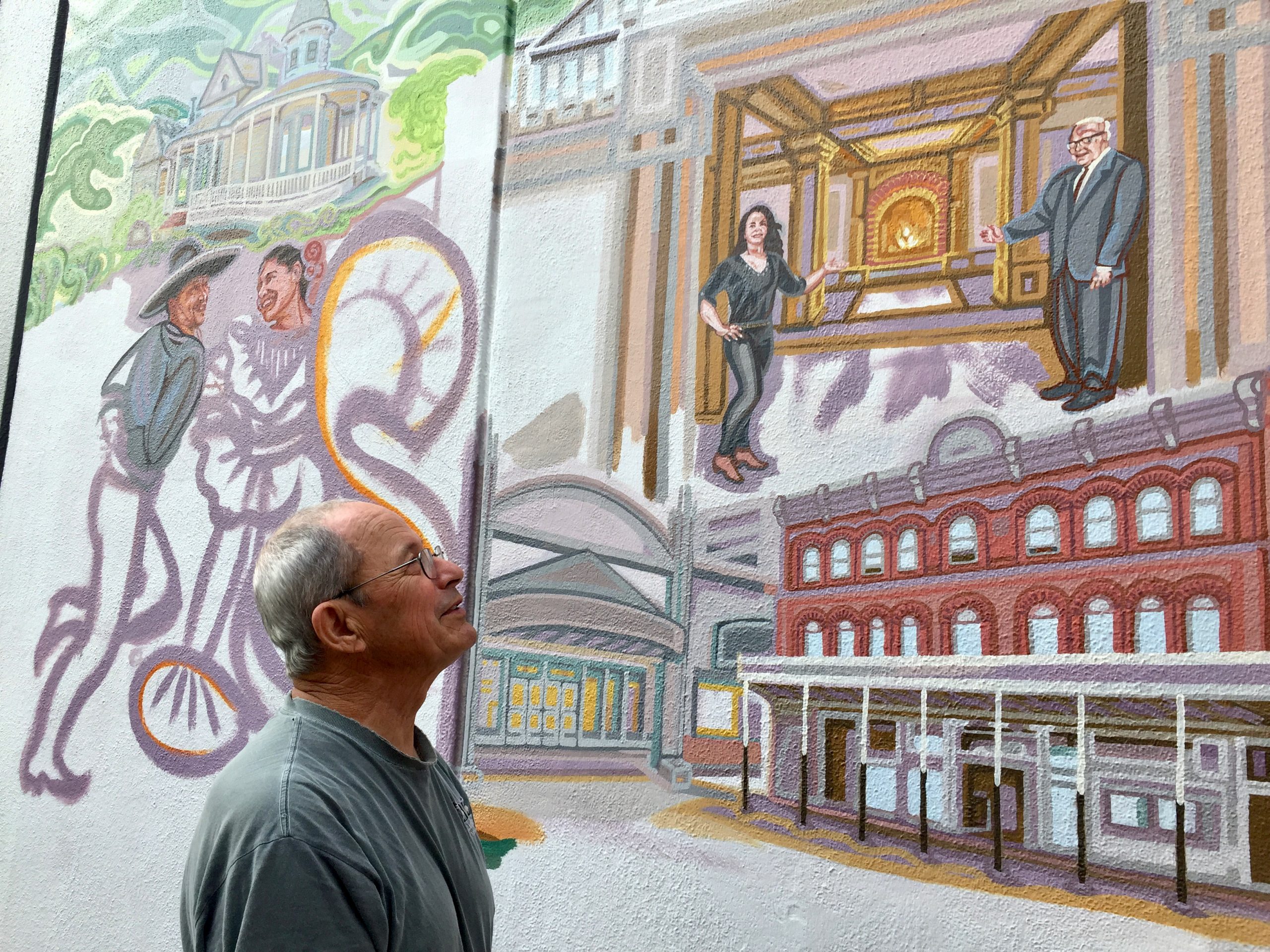
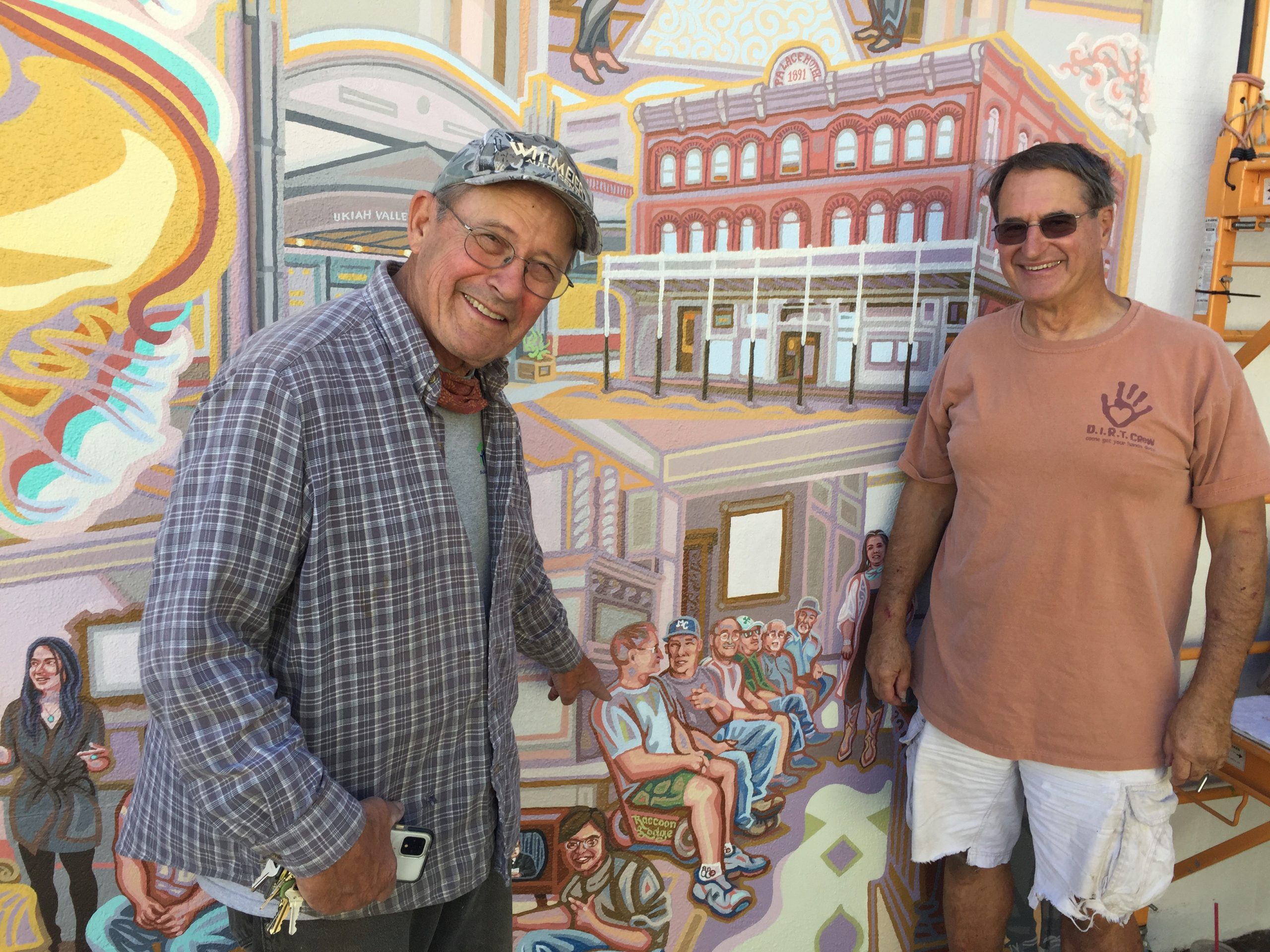
This brings us to the party scene at the bottom of the panel!
But first let me highlight the building portrayed next to the Palace: it’s the Conference Center itself, a portrait of the building painted on its very walls.

The Conference Center’s story is the result of a great idea. The building used to be a JC Penney’s department store mid-century, the largest in the county and Ukiah’s commercial heart. In the 1980s, Penney’s moved to a location with more parking on the edge of town. Another clothing store came in for a time, but then the building sat sadly empty. That changed when the city acquired it with the idea of combining small retail shops with meeting spaces large and small. This was a brilliant success, benefitting all the businesses downtown!
My notes from a conversation with Facilities Manager Kerry Randall (whose portrait is in the panel, below)

OK, back to that party!
The scene in the Palace parlor with its beautiful fireplace extends into the hospitality panel and then morphs into the historic Palace Hotel lobby.


In the middle of this scene are two young men watching a coin-operated TV, on which you see a face that I think you will recognize…
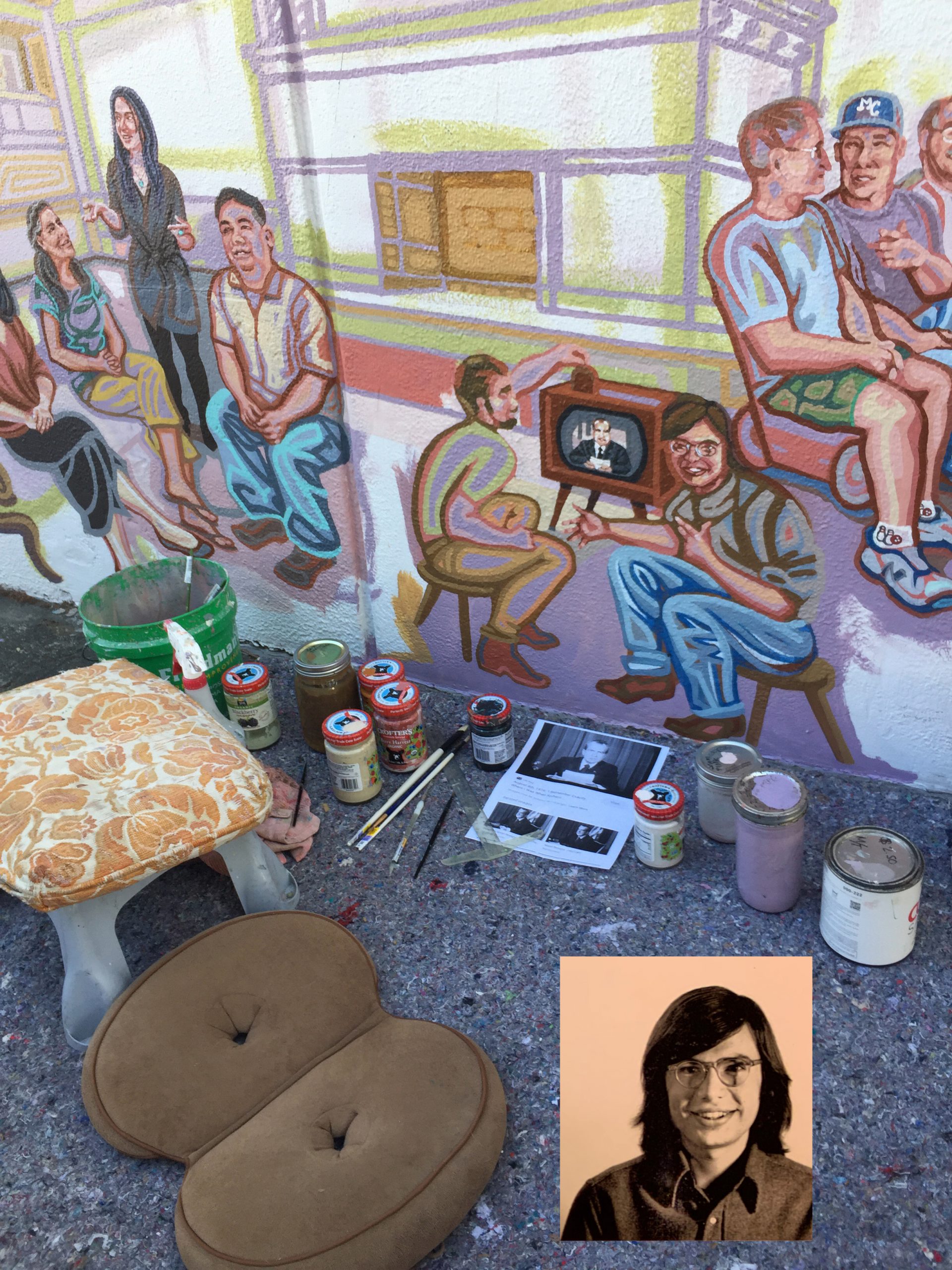
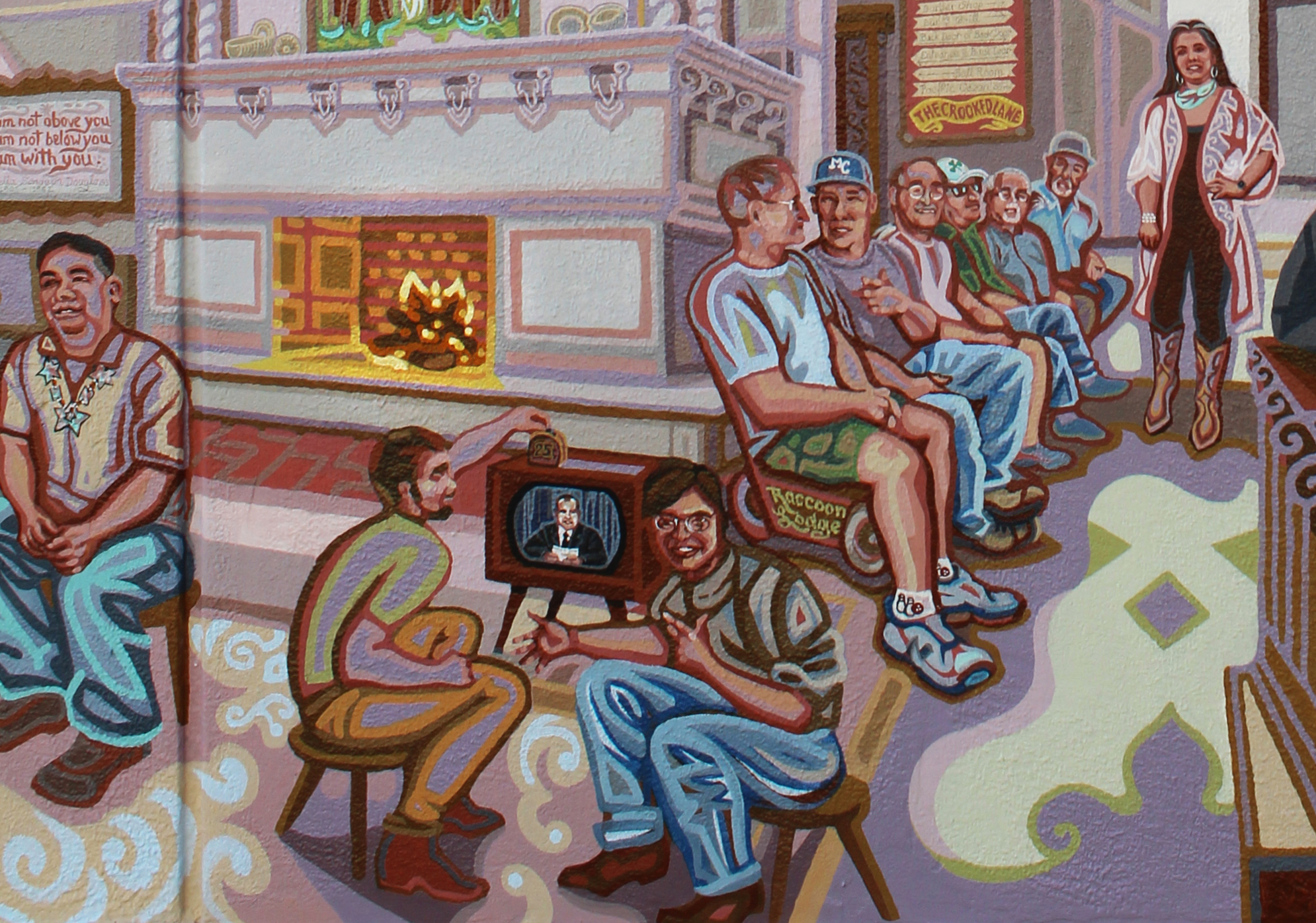
When local photographer Tom Liden moved to the area as a young man, he lived on the land without a lot of amenities. On August 8, 1974, he knew President Nixon was going to announce his resignation, and he ran into town with a buddy to find a TV. The Palace Hotel had one in the parlor! It operated on quarters, Tom remembered, and they pooled all their change to watch the speech amongst several older residents dozing in their chairs.
My notes from a conversation with Tom Liden
I told this story to Dave Poma (seen in the mural above young Tom) and he said, “That set was from Poma TV! We provided it free to the hotel and kept the quarters . It was a good money maker for us and great for the guests.”
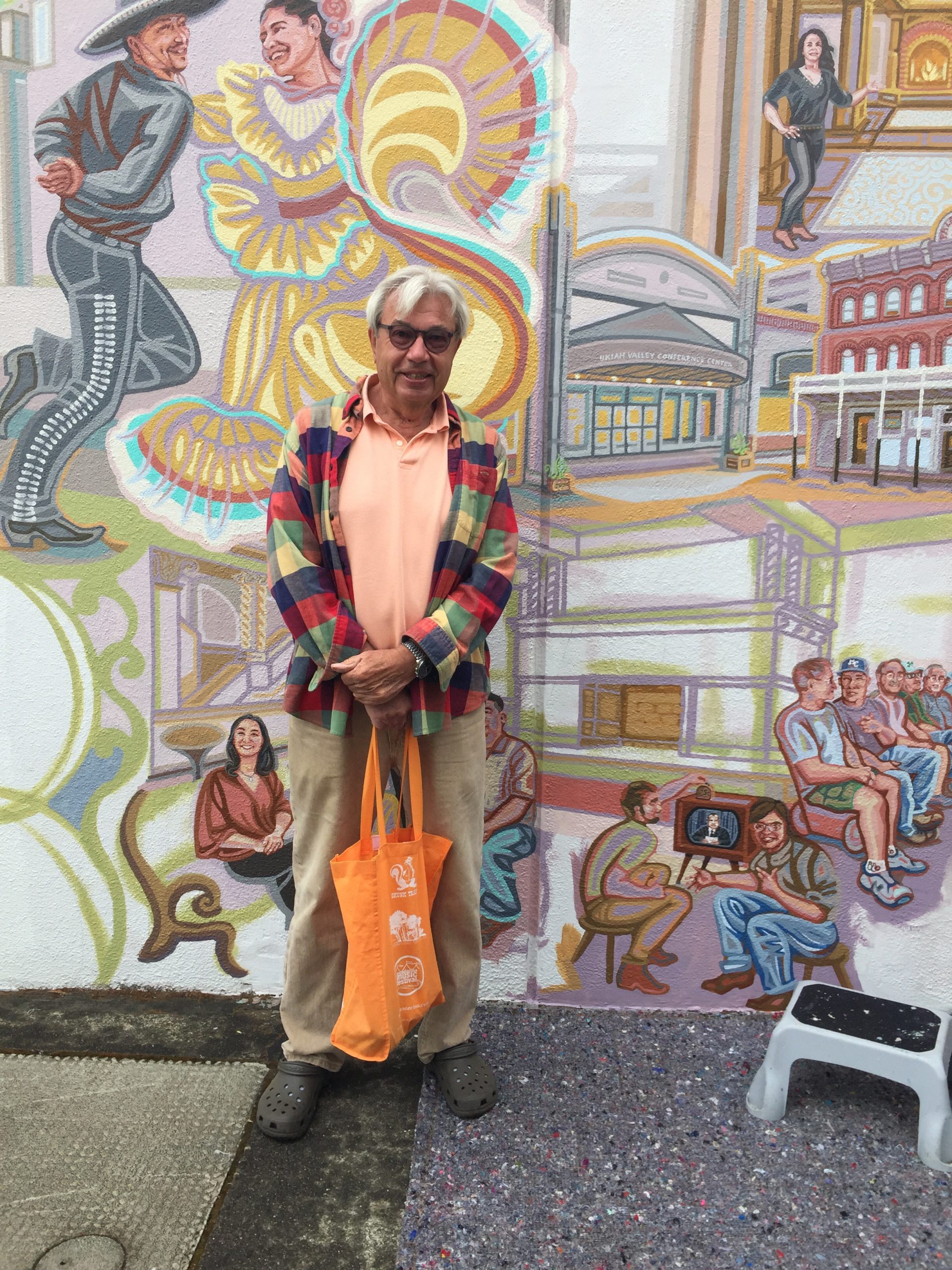
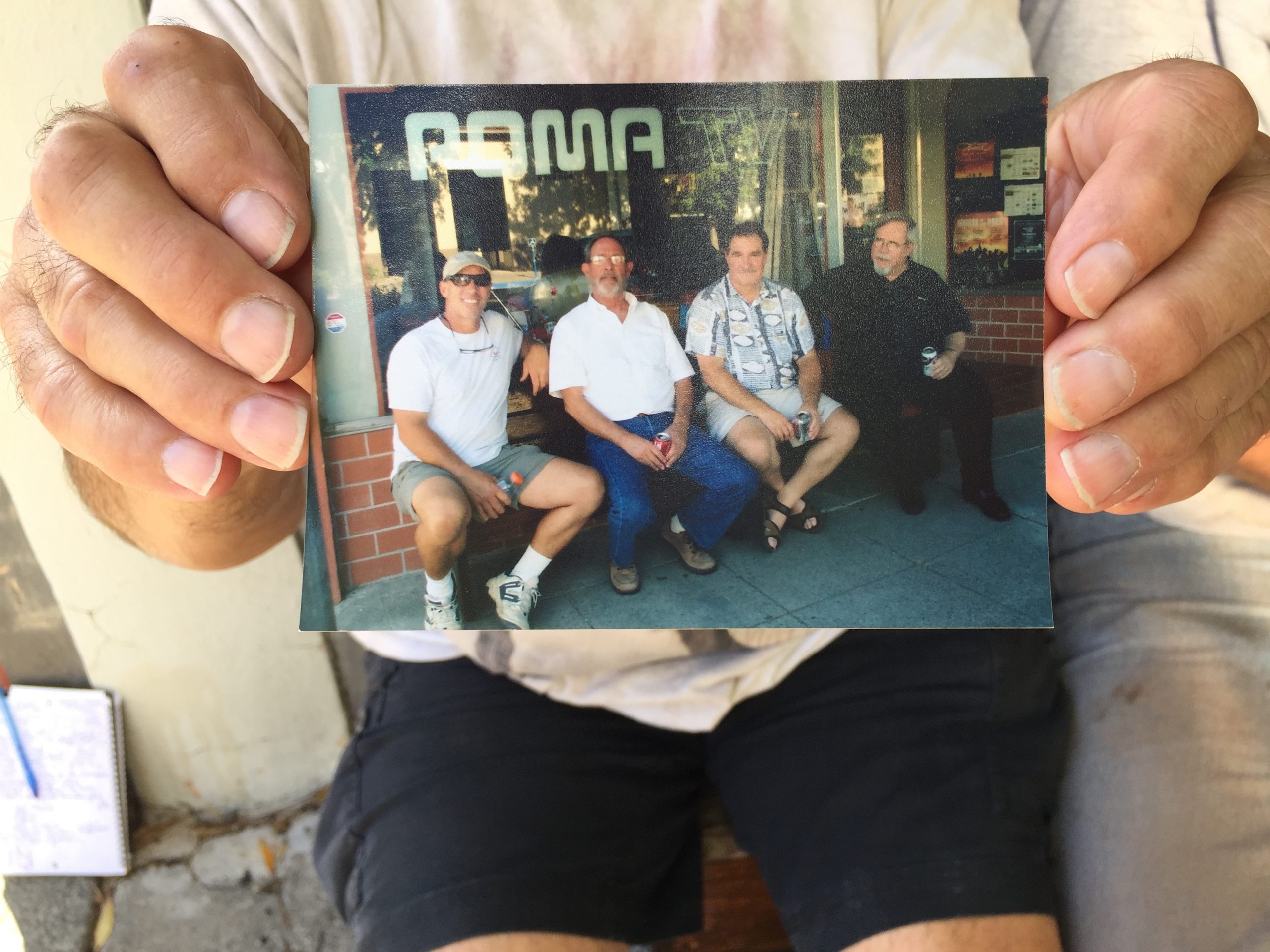
The Raccoon Lodge
Those guys sitting in front of Poma TV are the stars of the next scene, a depiction of the Raccoon Lodge. This group of men have been friends hanging out on a moveable bench and shooting the breeze for at least thirty years!
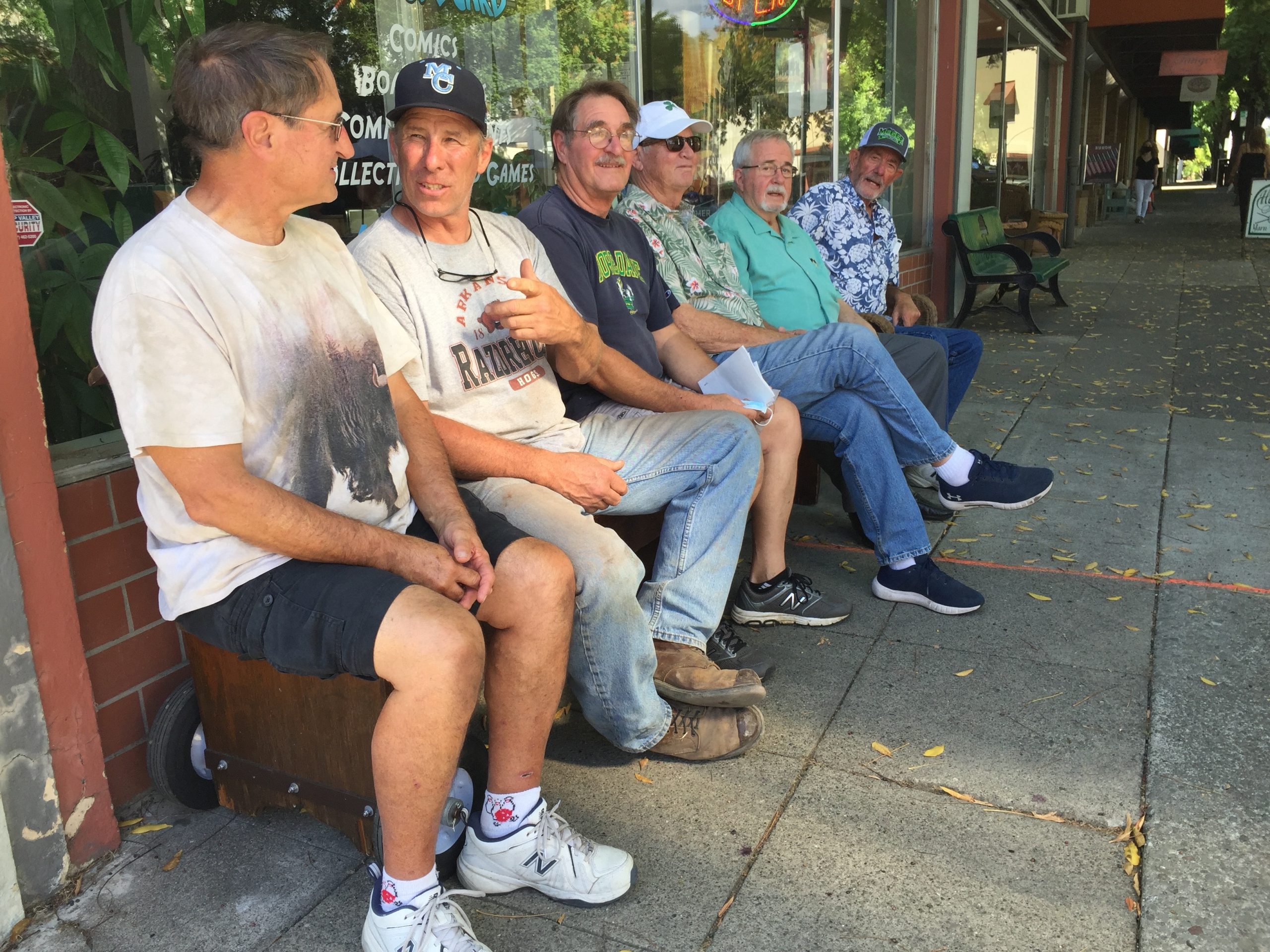
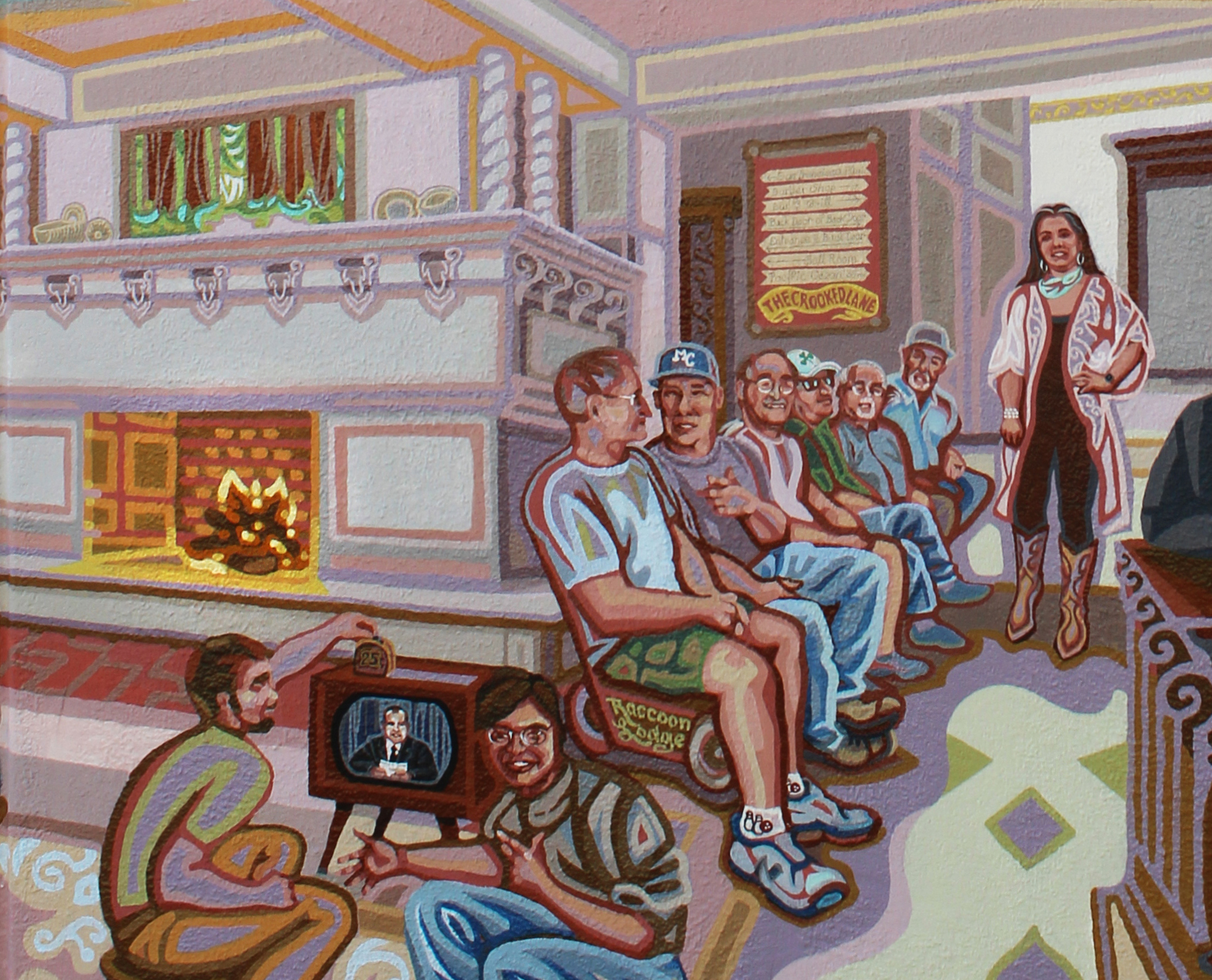
The Raccoon Lodgers depicted here are, from left to right, Dave Poma, Jeff Trouette, Bruce Poma, Pat Walsh, Mike Spencer and Mike Rogers. I pay attention to mannerisms, like the way Jeff sits with one foot on top of the other. Notice Dave’s socks…

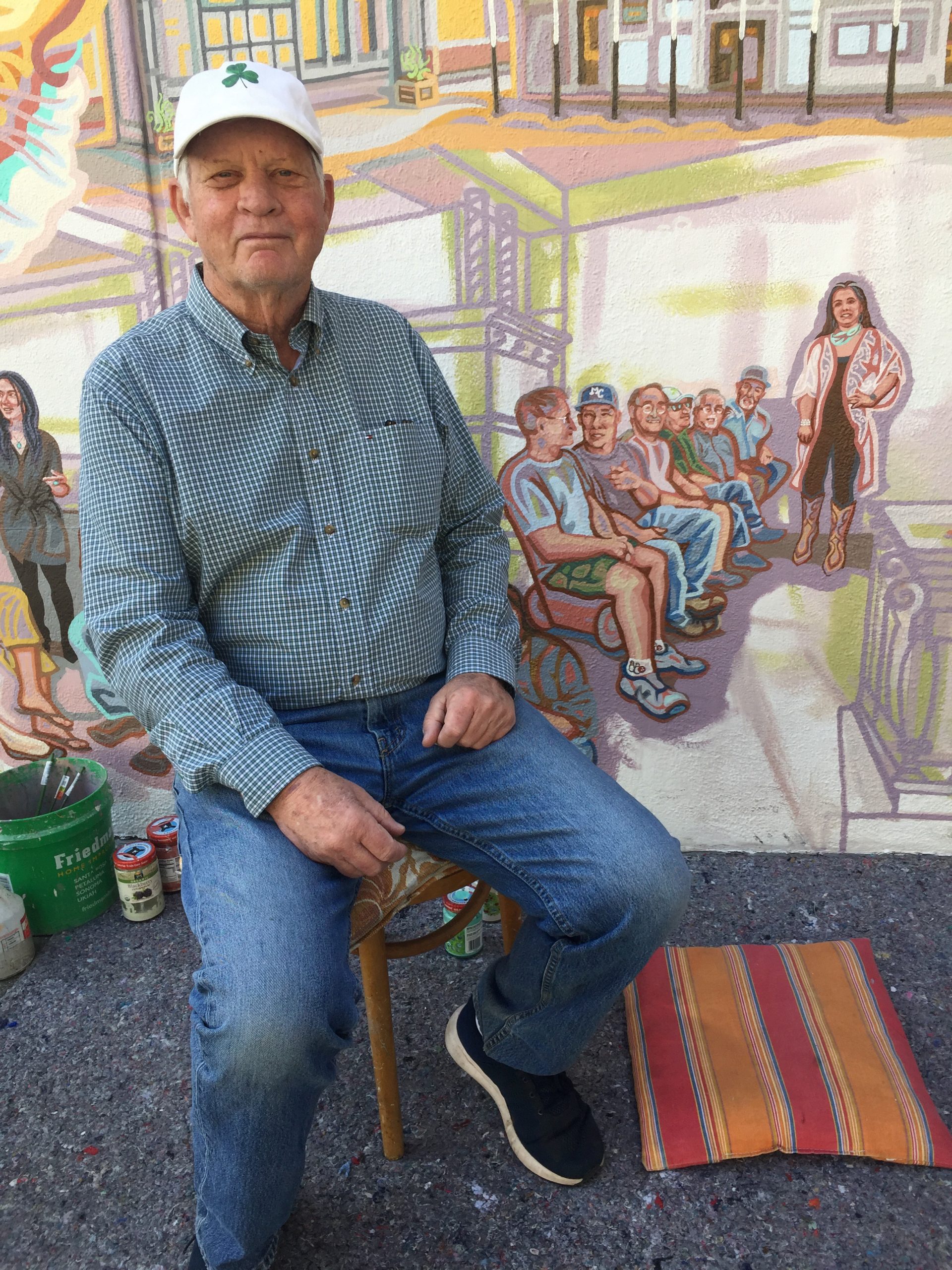
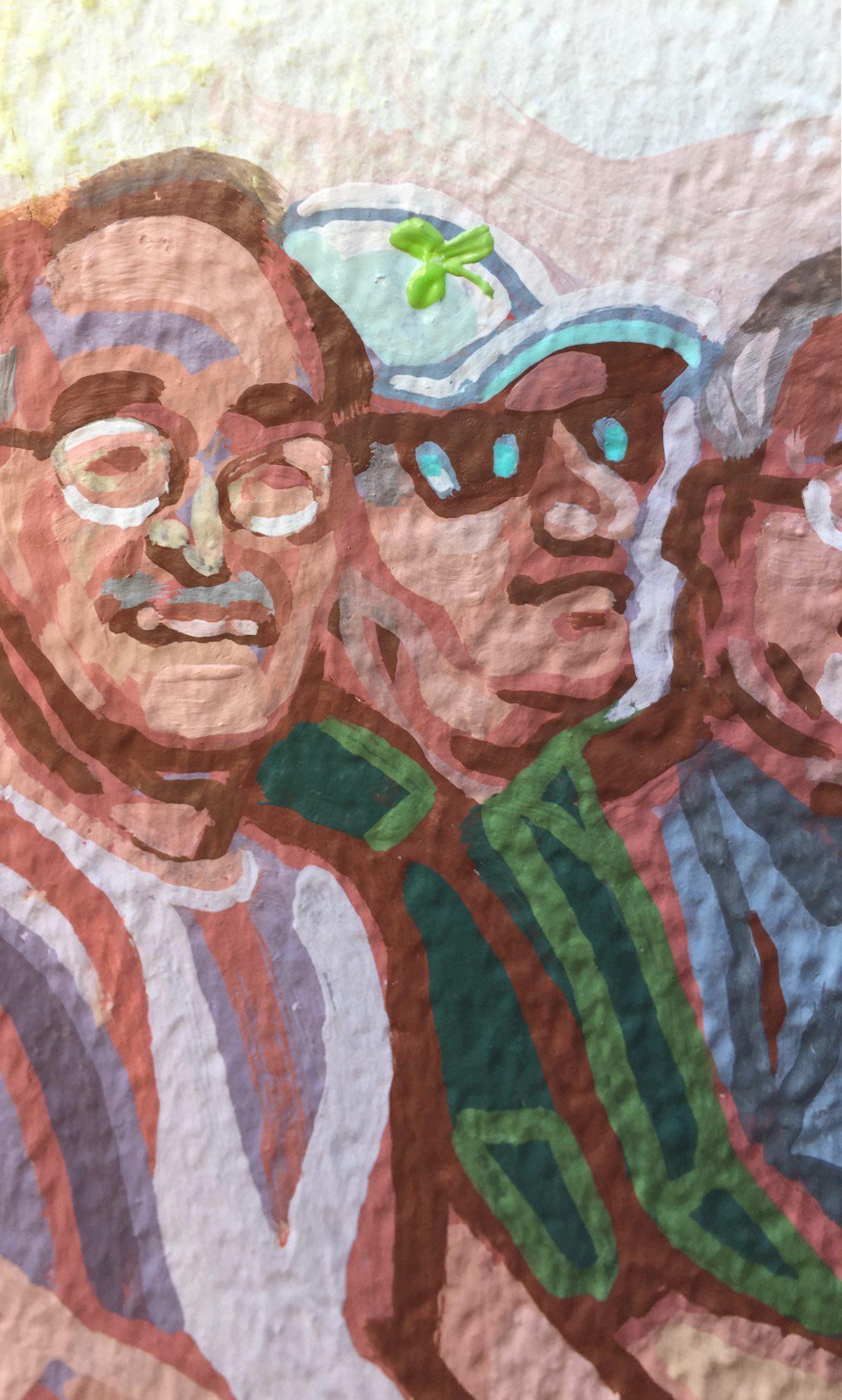
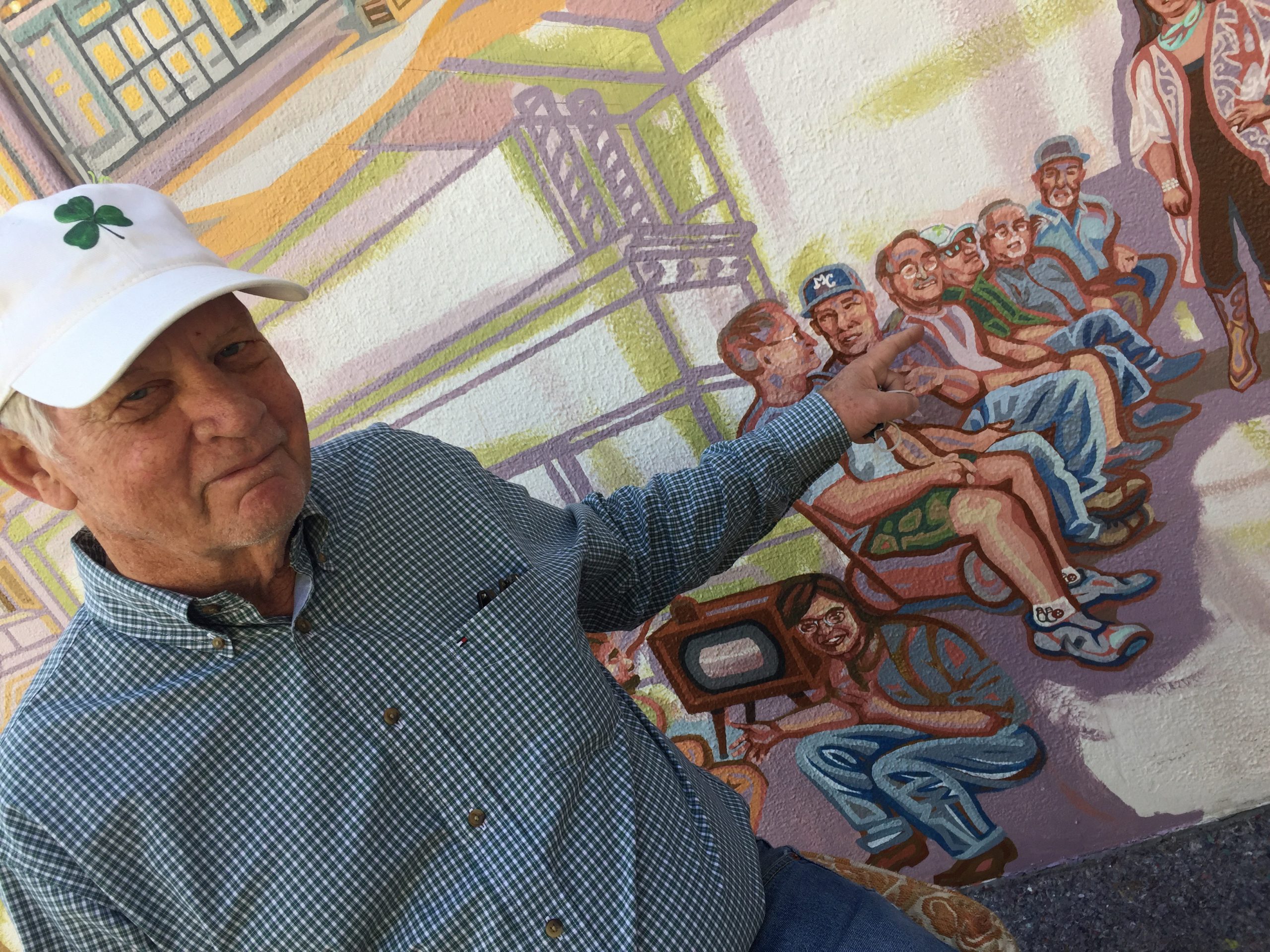
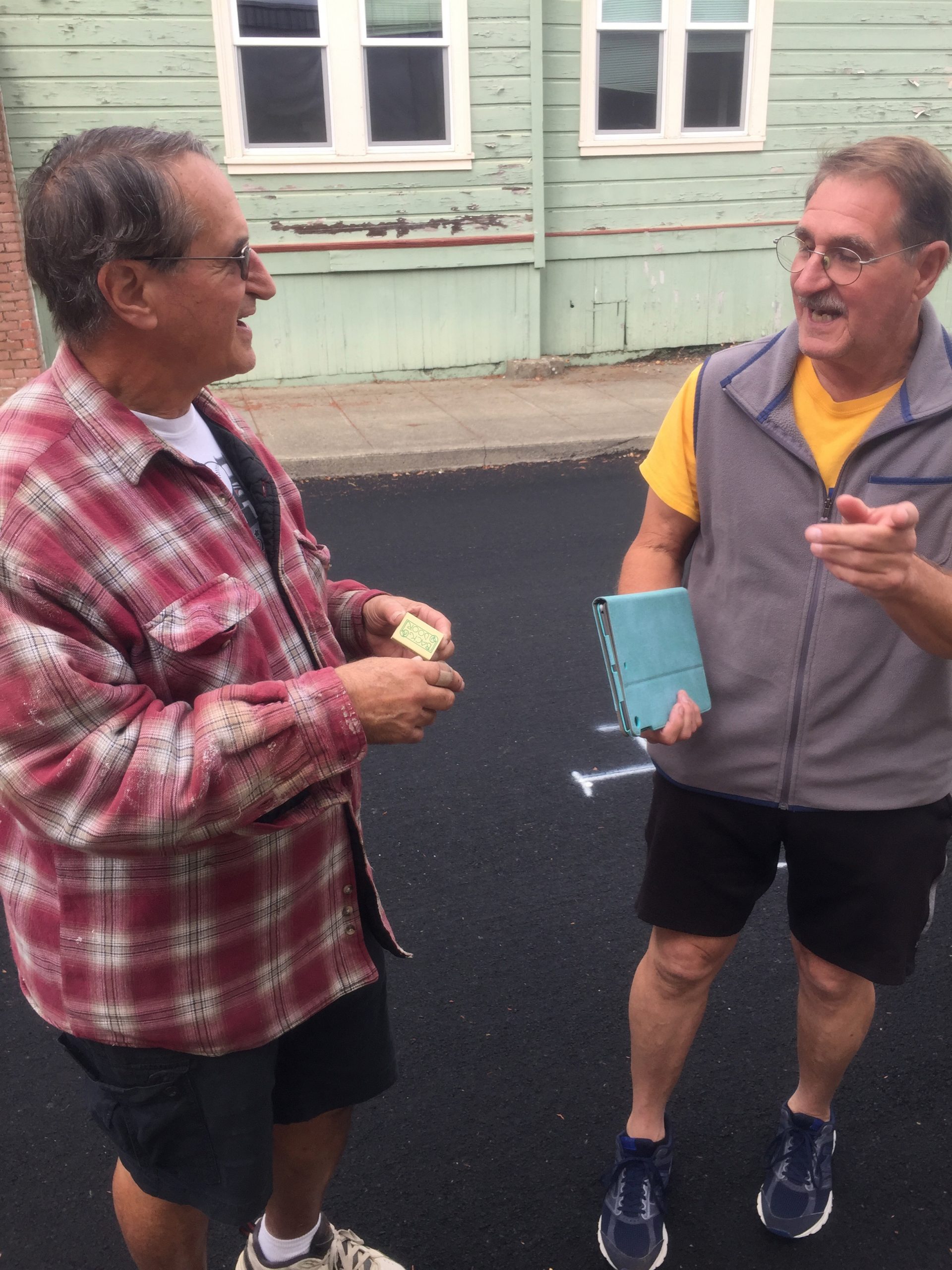
Dave wore socks he bought at Ukiah’s well-loved bowling alley, Yokayo Bowl. He wanted to honor the owner Mike Schutz, who was forced to close his business recently.
Pat Walsh liked my portrait of him but I hadn’t noticed the shamrock on his cap, which represents his strong Irish pride. So I painted it using my tiny brush. (My name’s Irish too, so I understand! The Sinnotts live south of Dublin in County Wexford.)
The Raccoon Lodge bench was converted from a choir pew in St. Mary of the Angels Catholic Church (now SPACE Theater) which I painted in the creativity panel (see below).
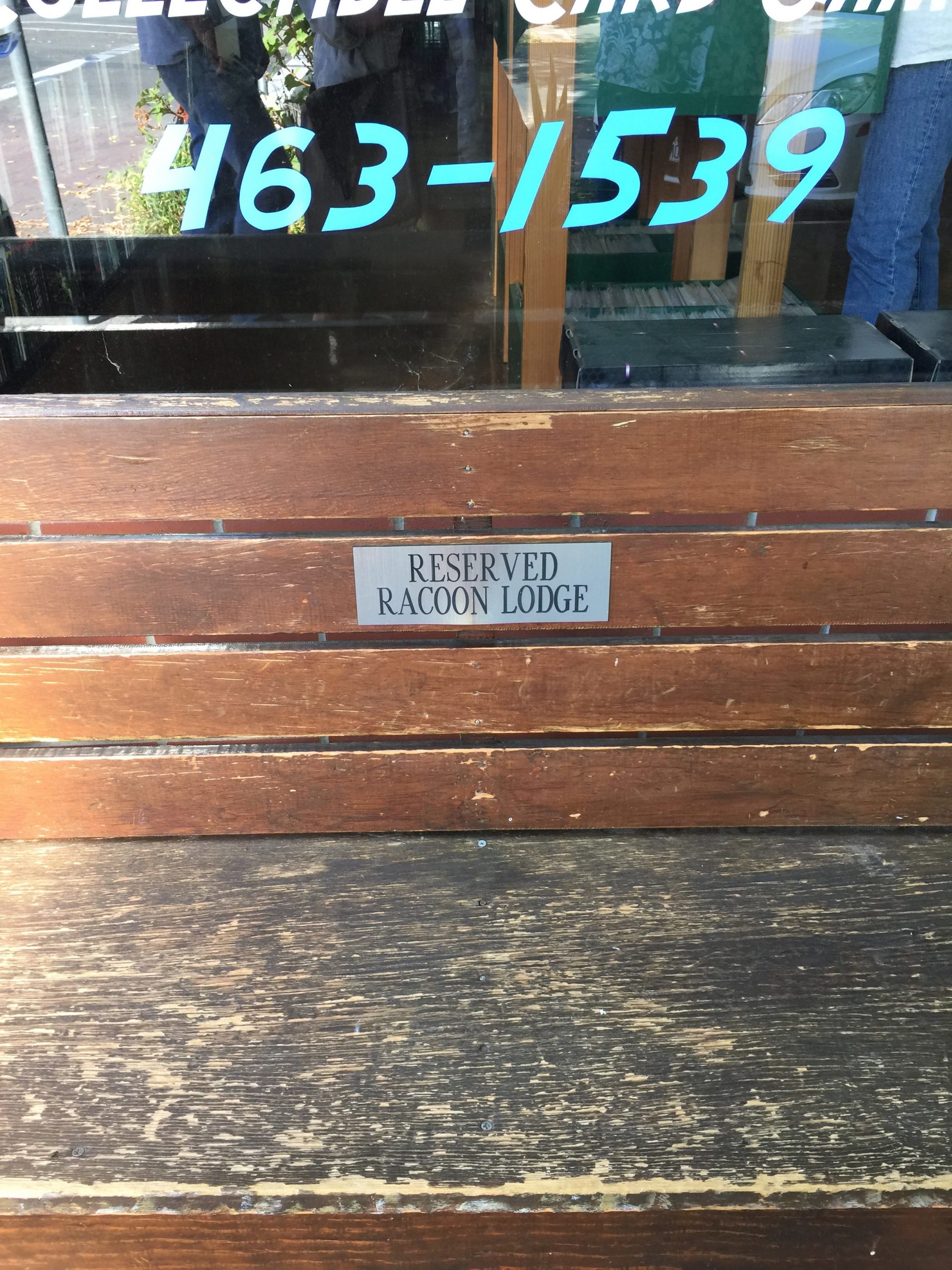
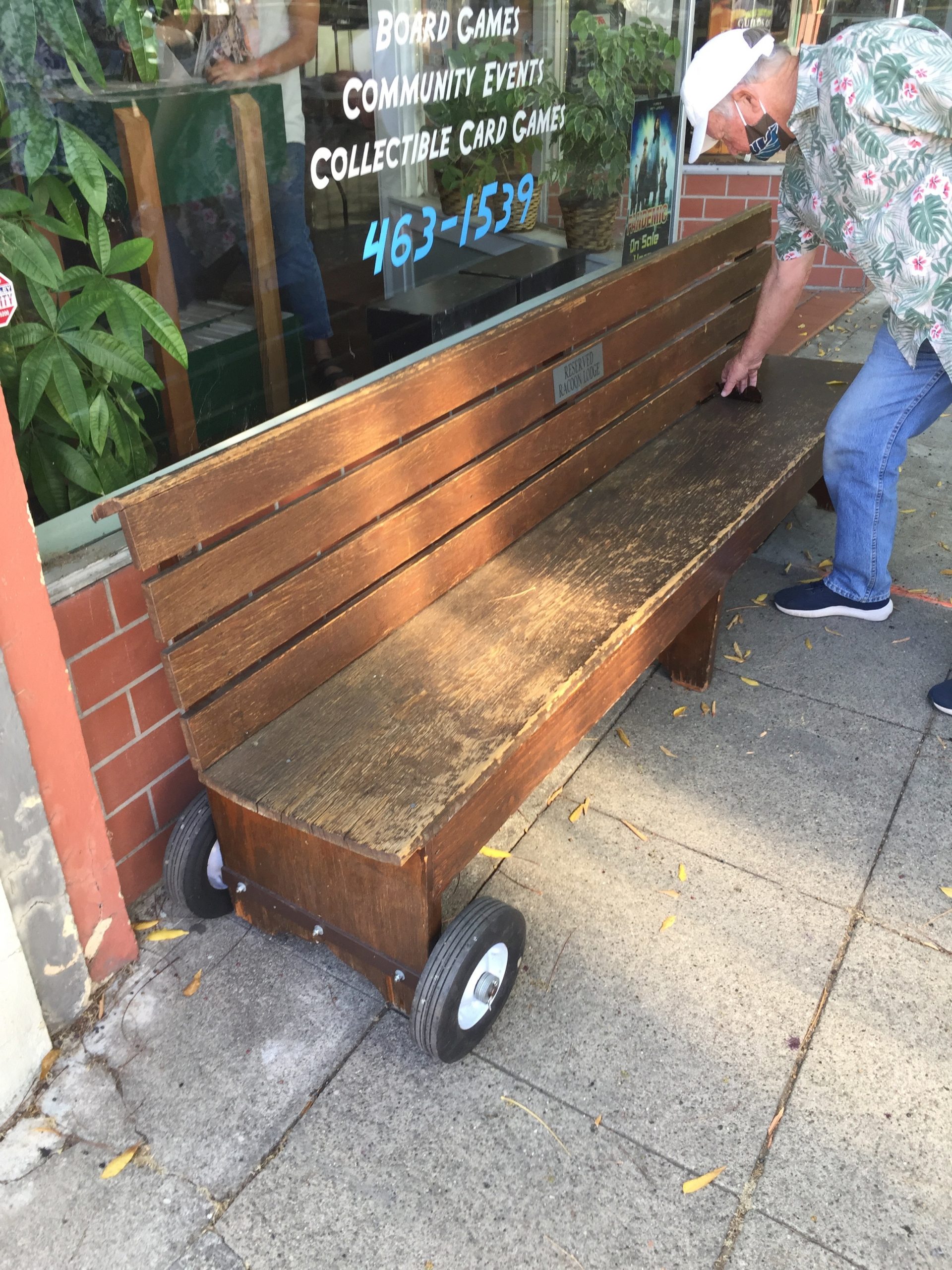
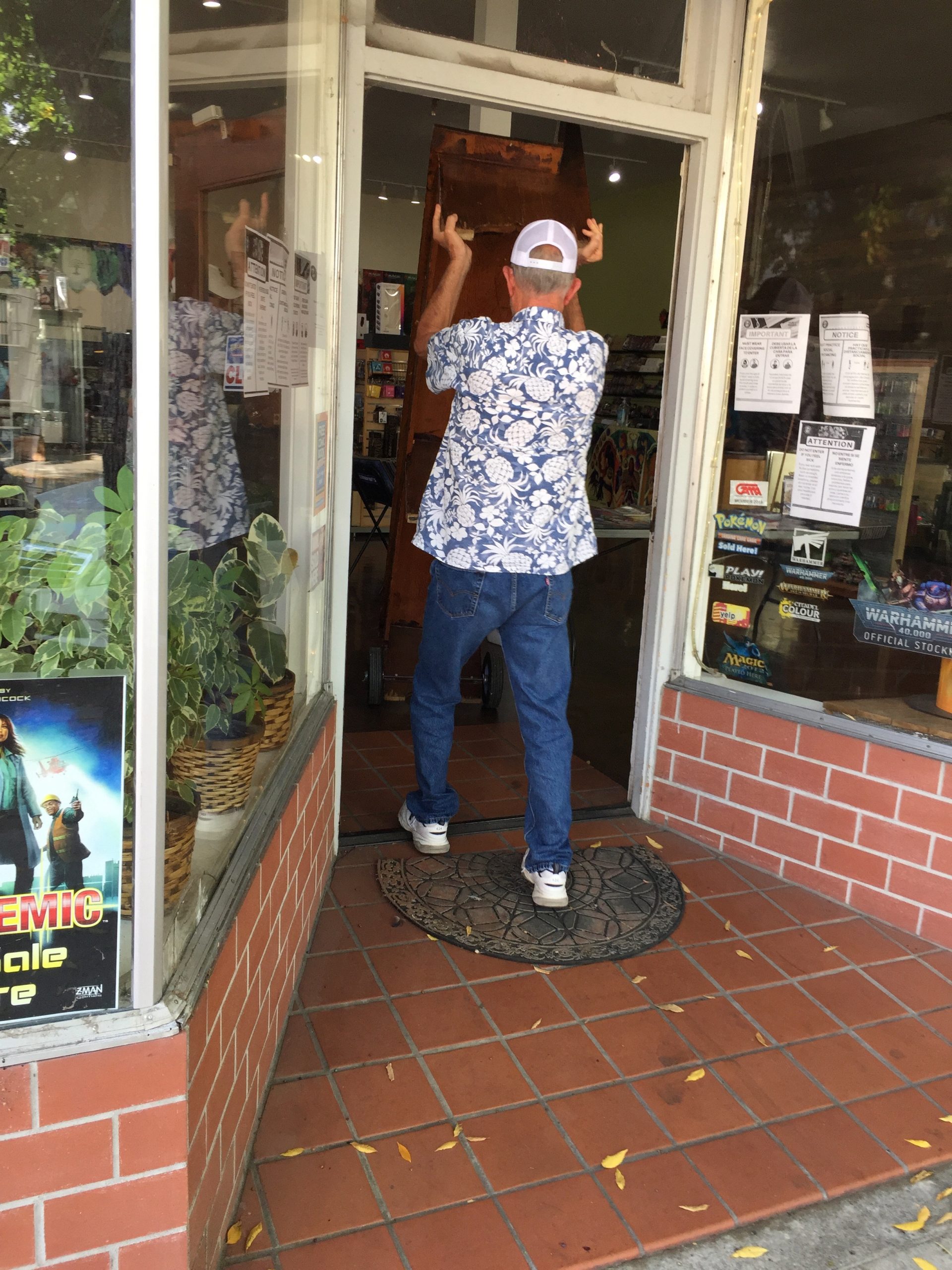
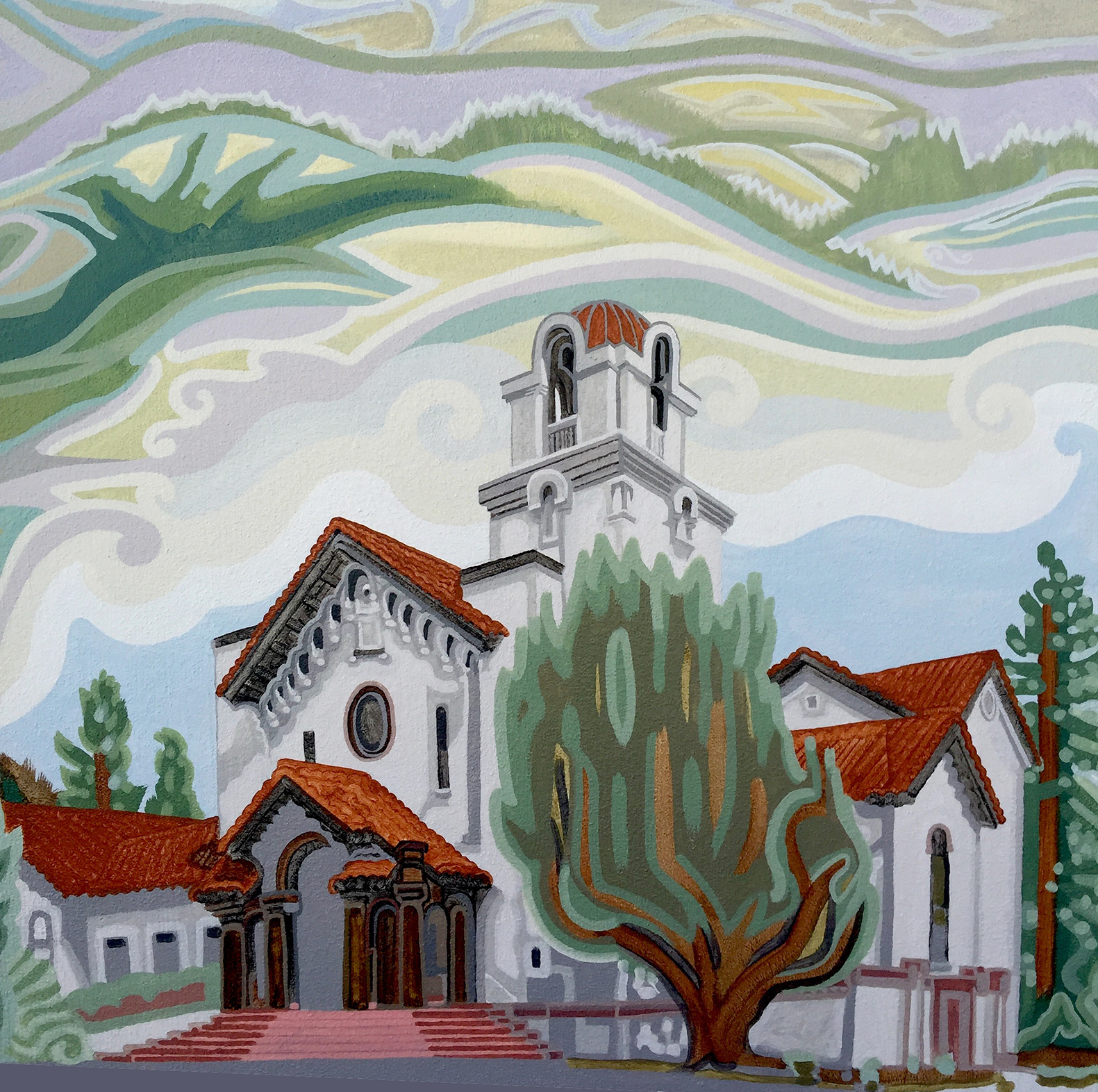
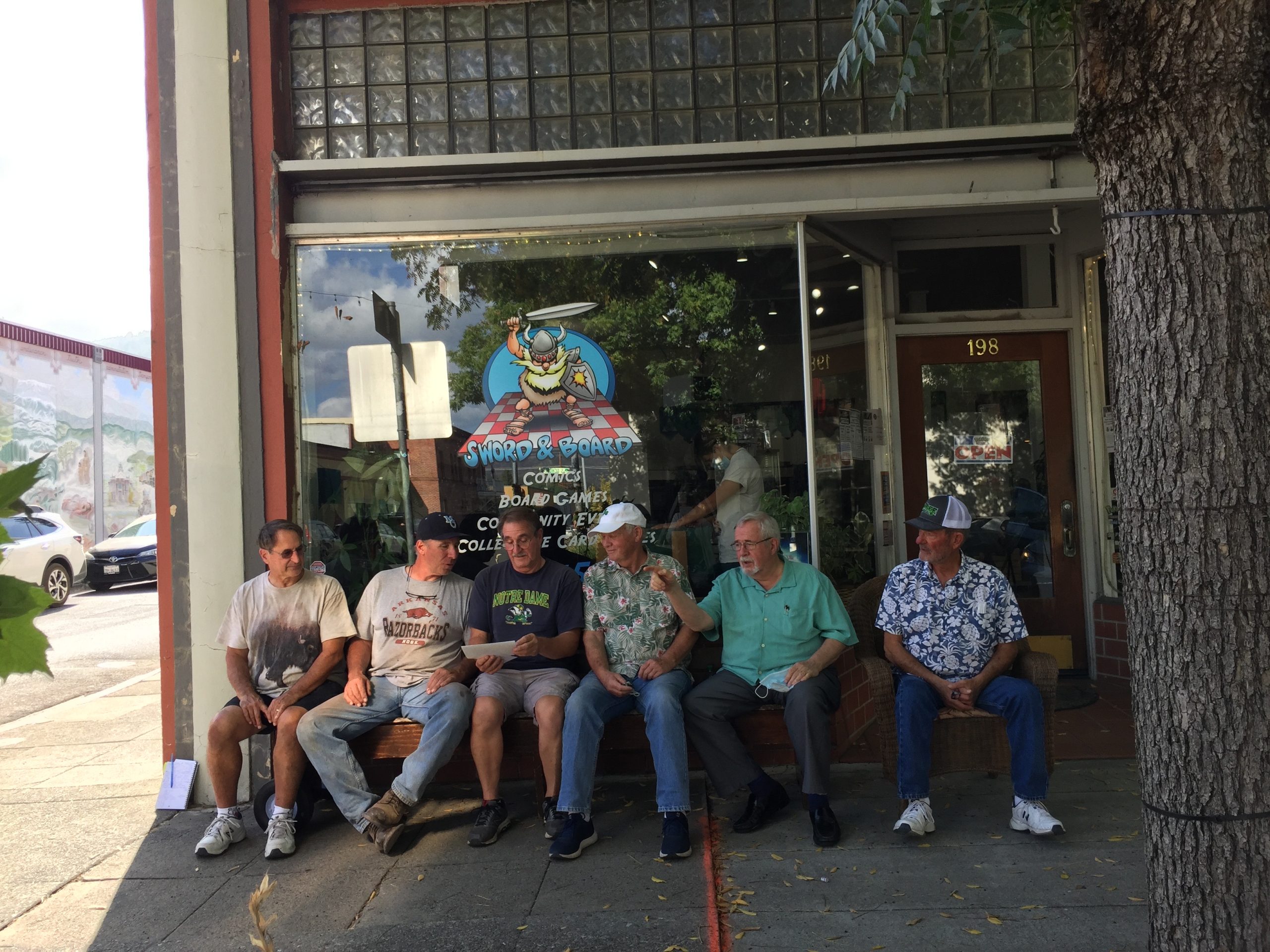
A sign hanging on the Palace wall above the Raccoon Lodge in the mural was painted from a humorous actual sign. It guided people into a meandering hallway that led from the front of the hotel to the dining hall, ballroom, and businesses in the back:
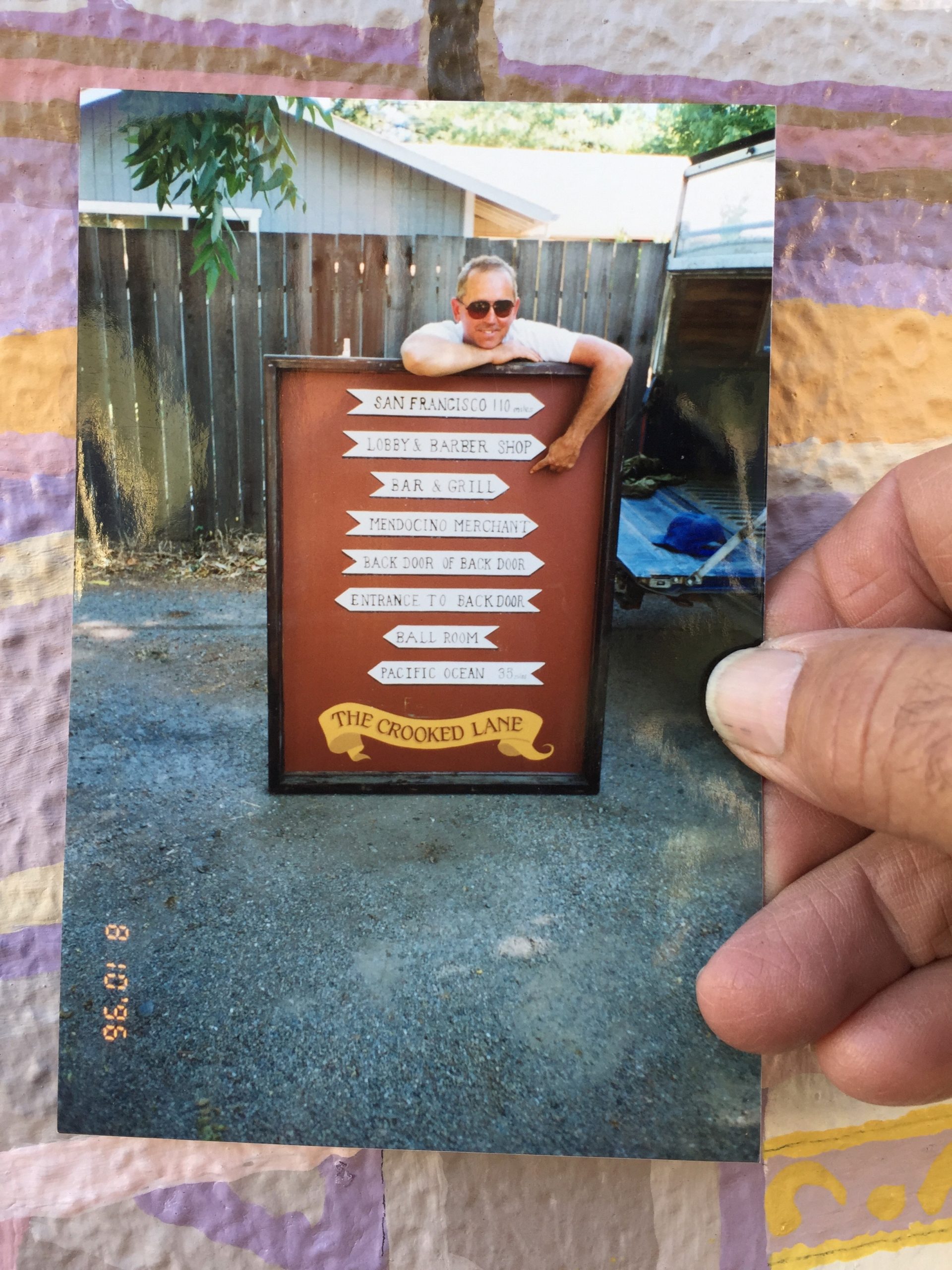
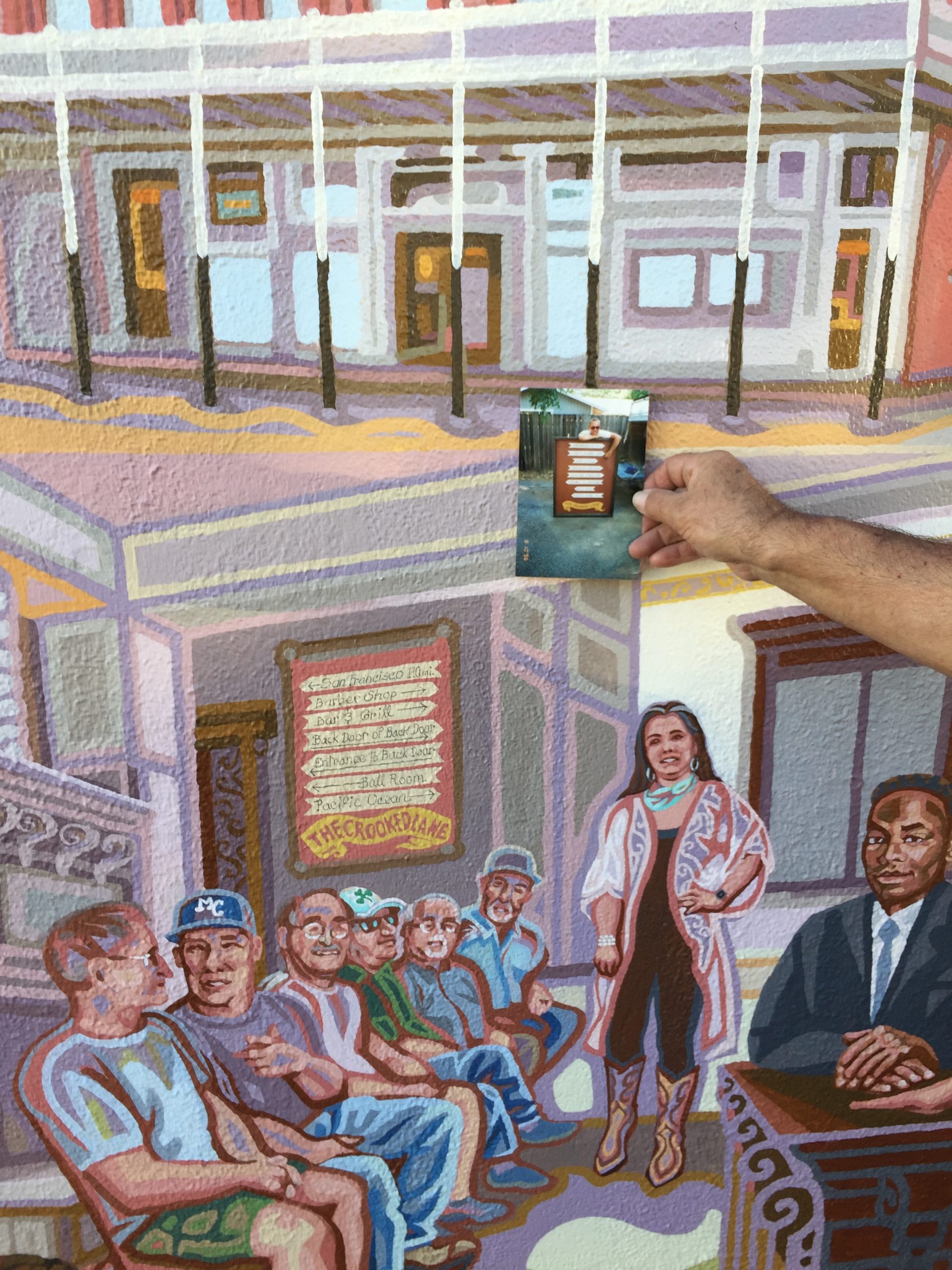
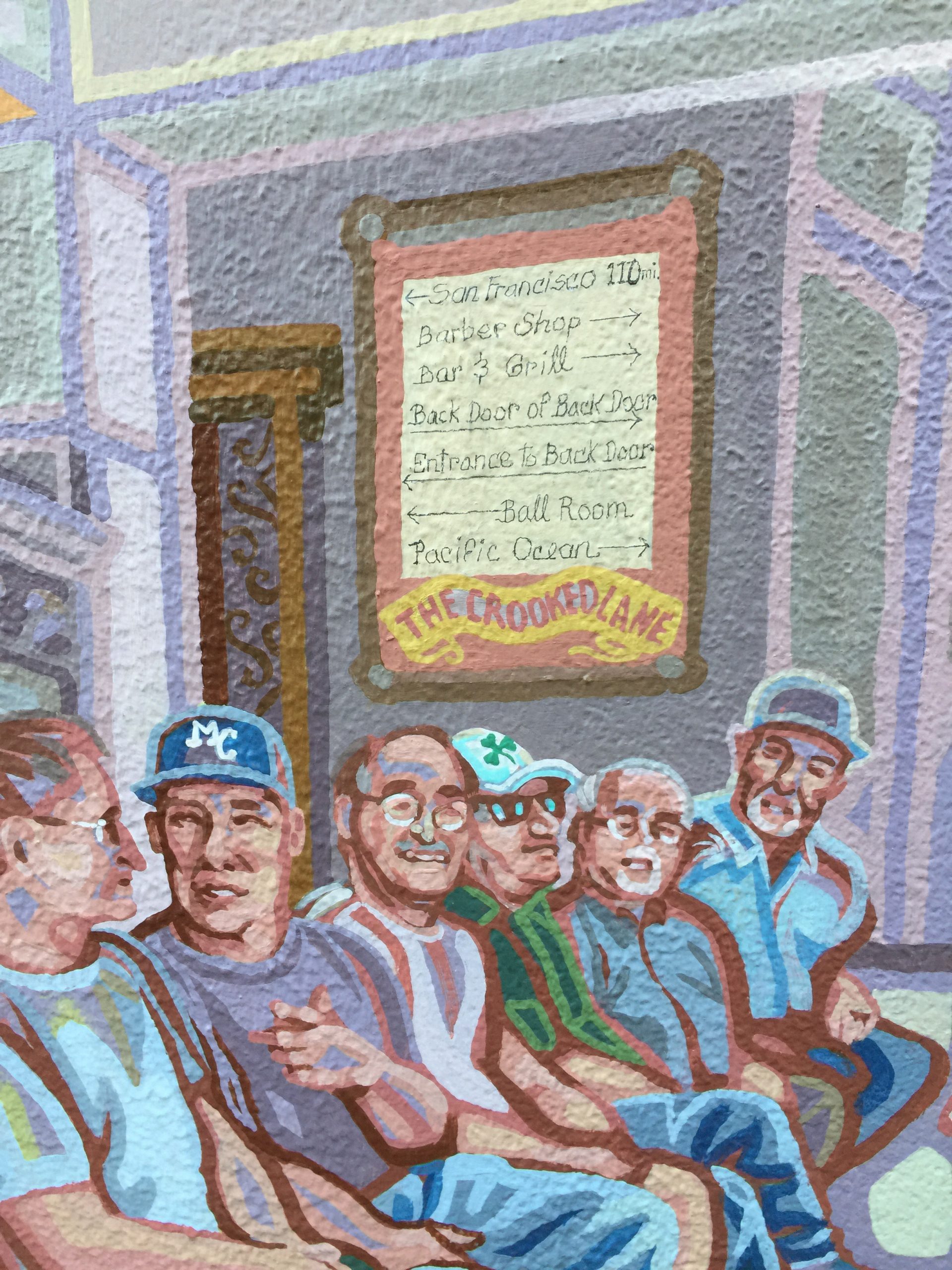
Including the “Entrance to the Back Door” and the “Back door of Back Door” – the Back Door was a bar.

Notice the woman near the Raccoon Lodge guys. As I was painting these panels in 2020, she and one of the women on the couch in the heritage panel were running against one another in the race for county supervisor!
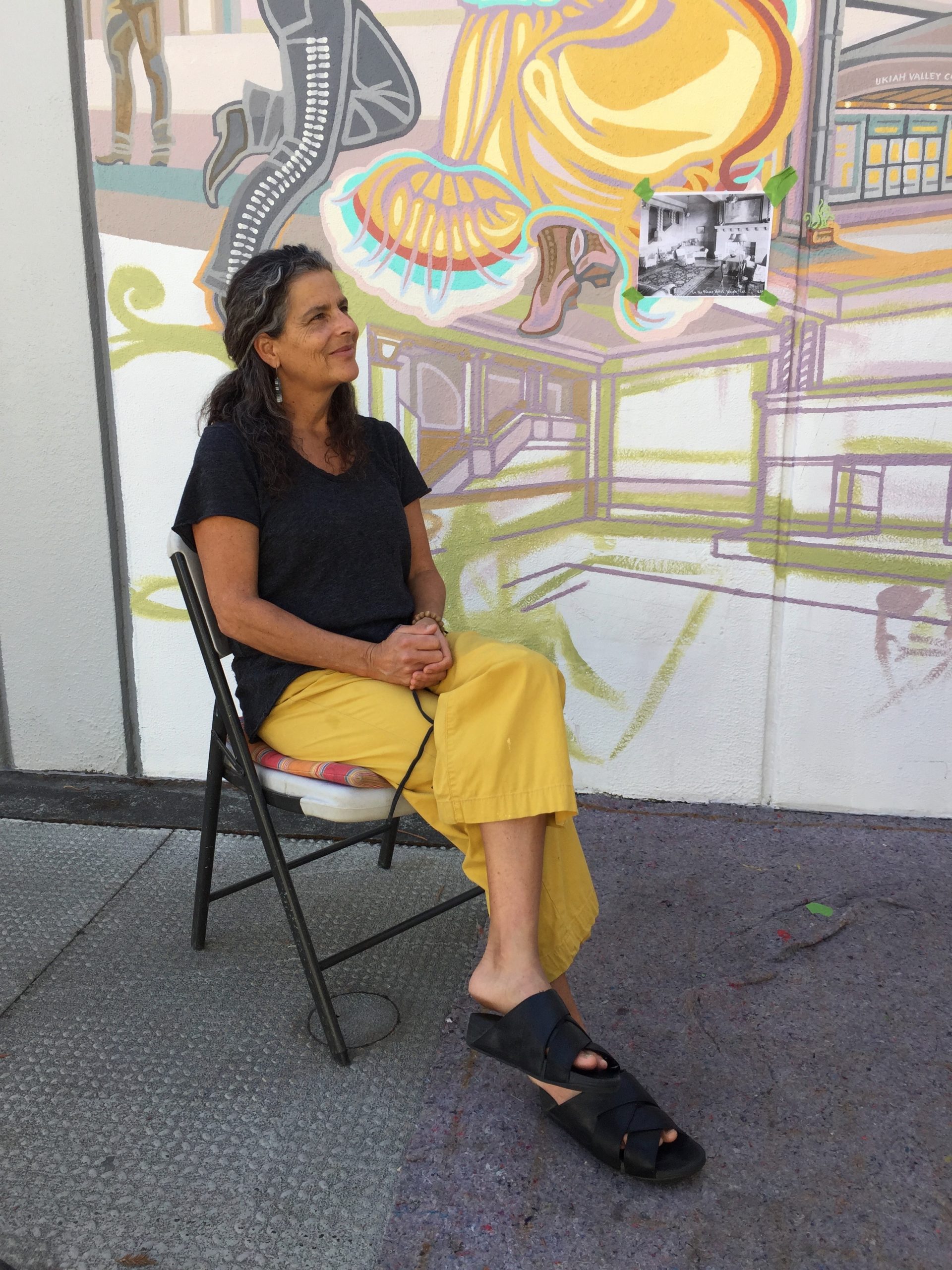
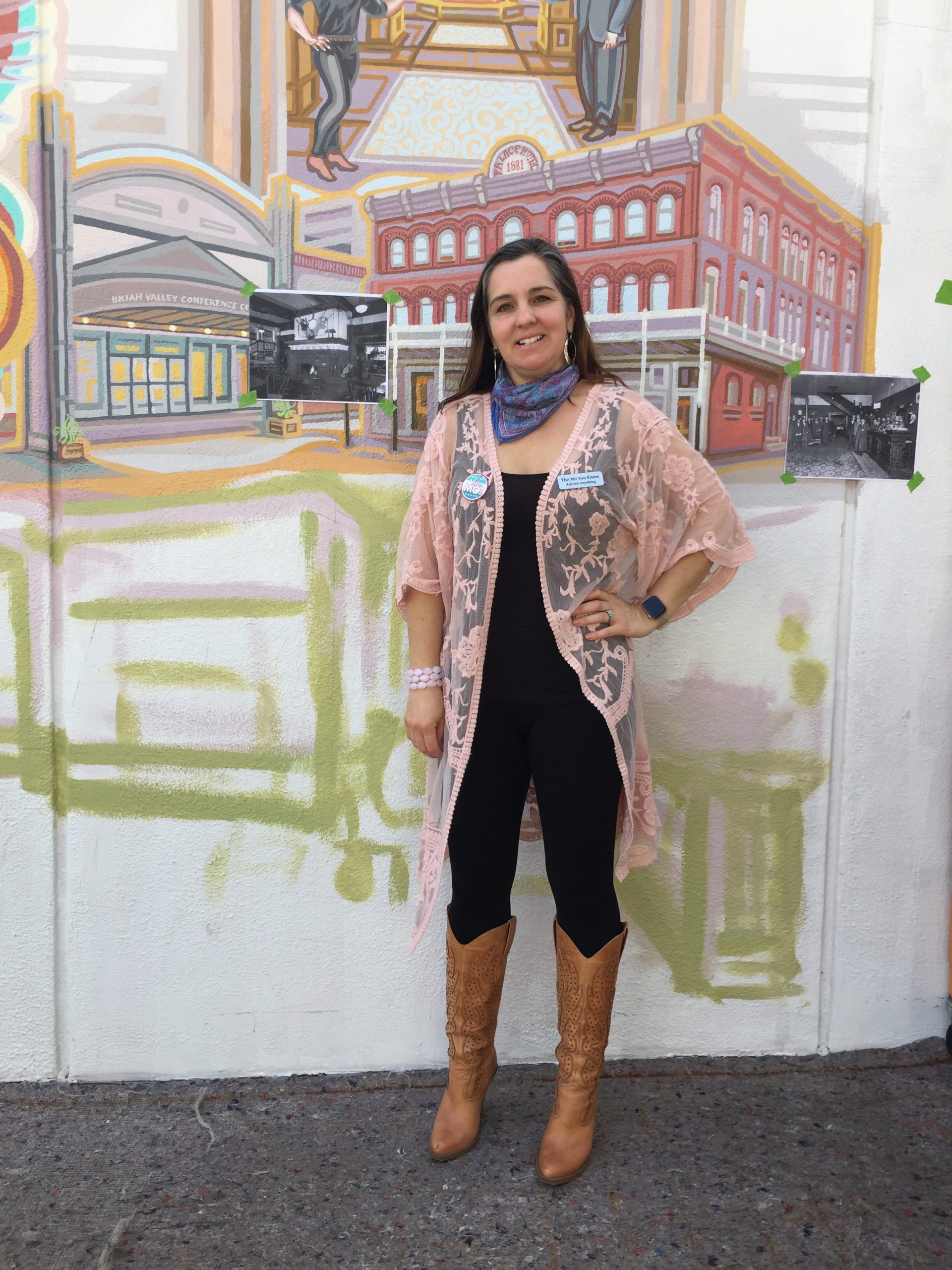
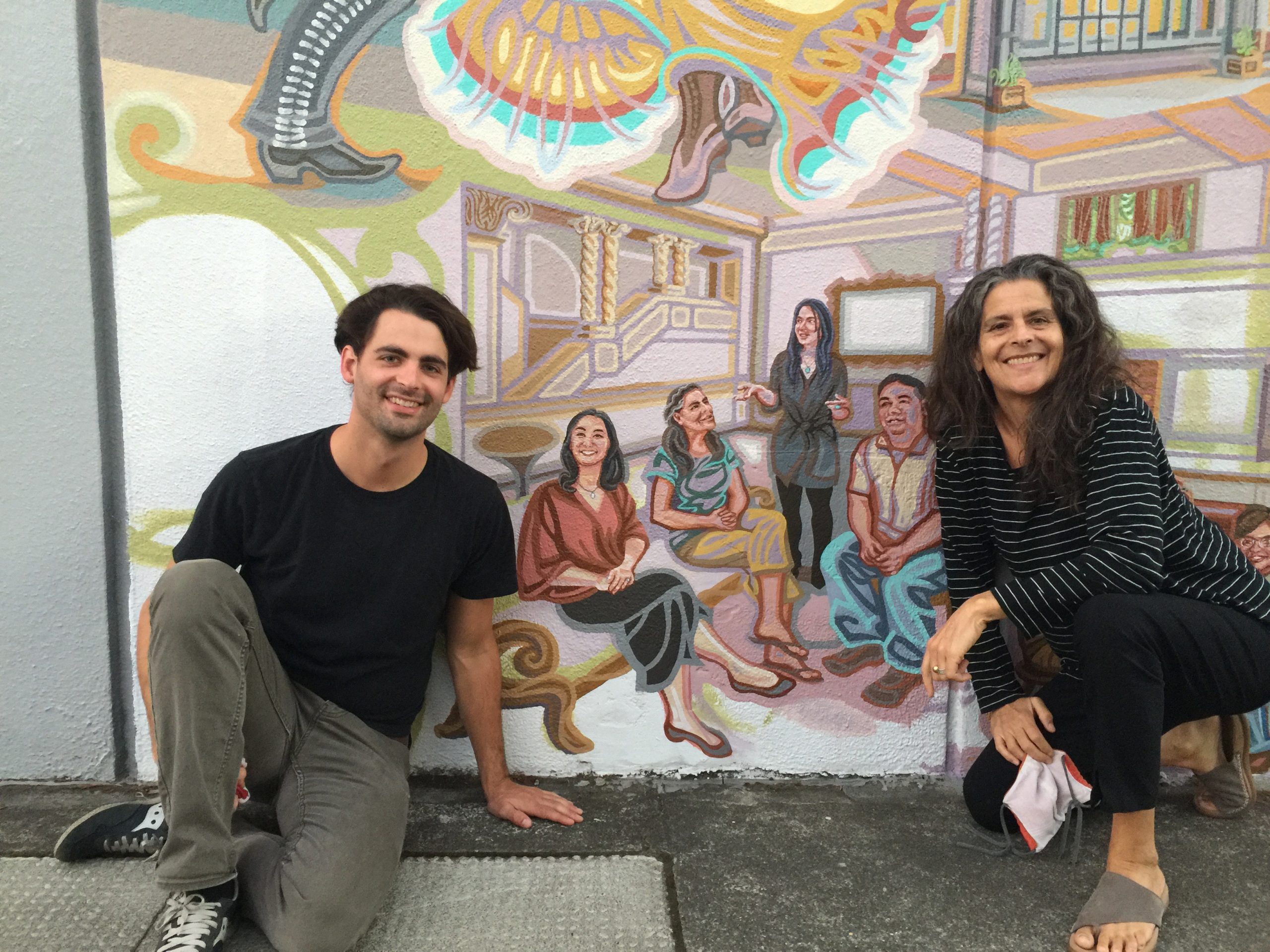
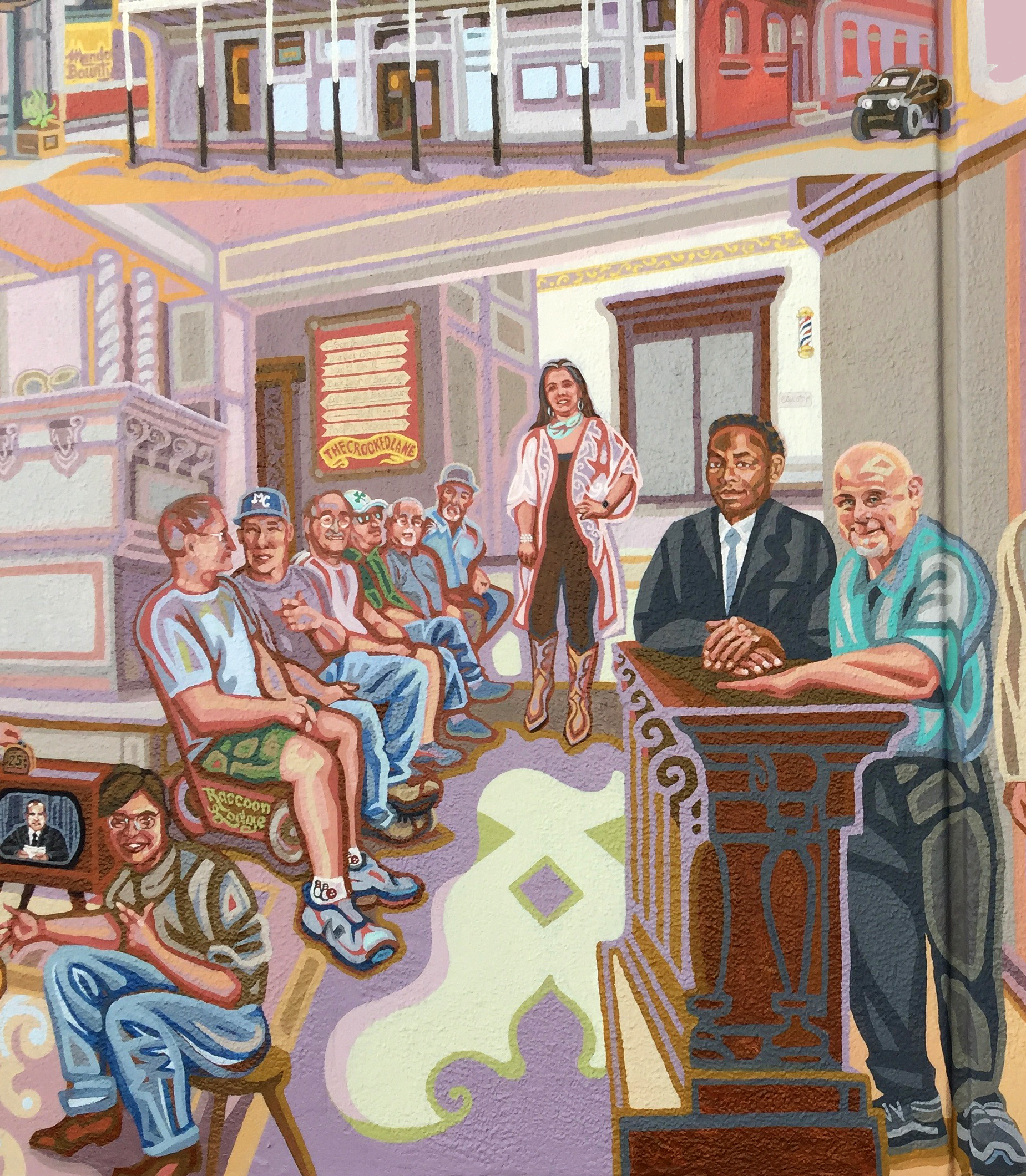
Mo won the Supervisor’s race a few weeks after I painted her. In an interesting twist, Mari was appointed to replace Mo on the Ukiah City Council, a seat she herself had held before!
The purest hospitality
The two men standing at the lobby counter represent the purest hospitality, which is inclusive and welcoming to all. But they are also portraits. Kerry Randall, the Conference Center Facilities Administrator, stands in the foreground on the right. He wasn’t busy enough at work (I’m joking), so he and his partner run a ranch with farm animals, water fowl, many beloved dogs and rescued race horses.
But who is the younger man in a suit?
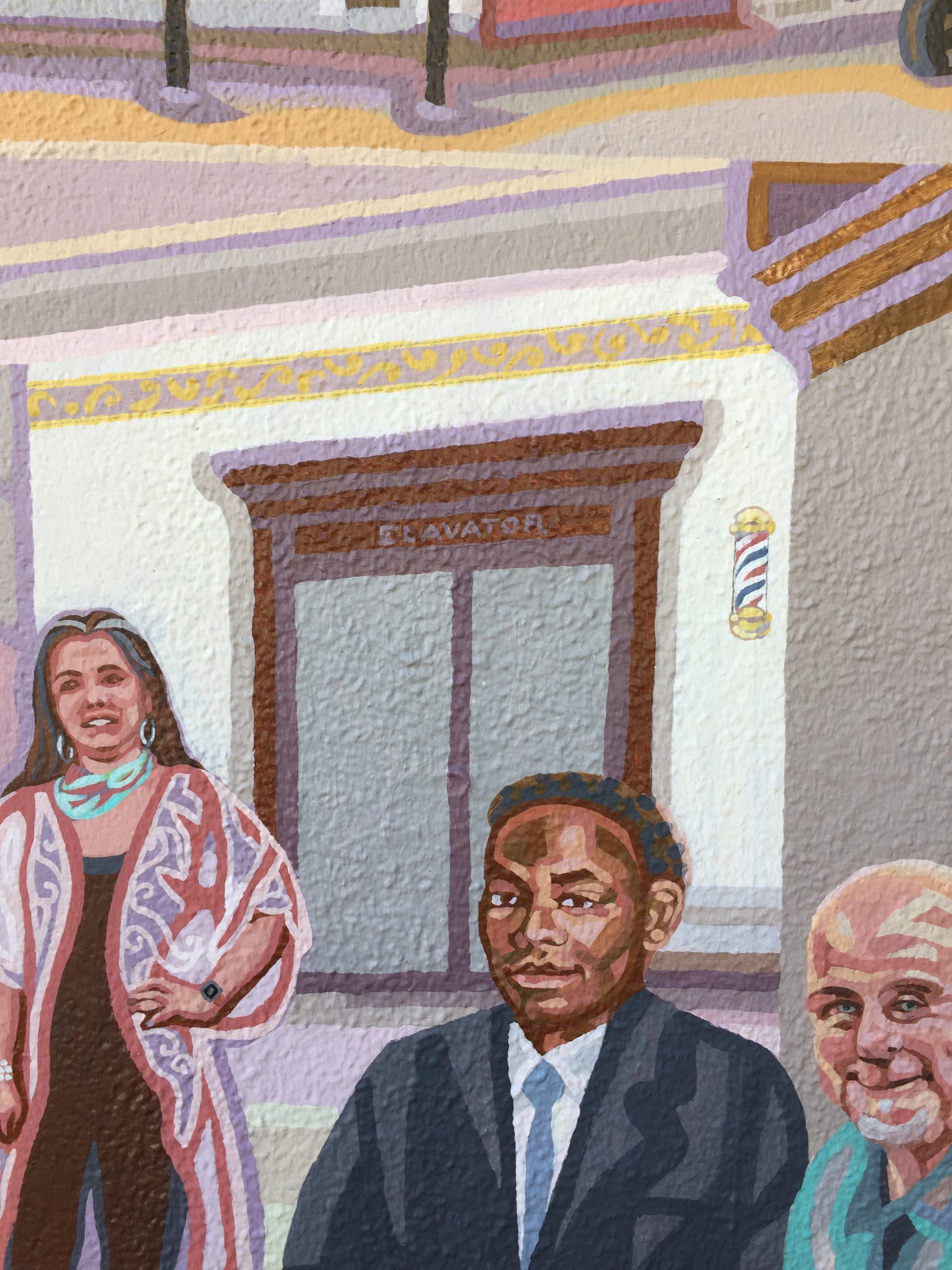
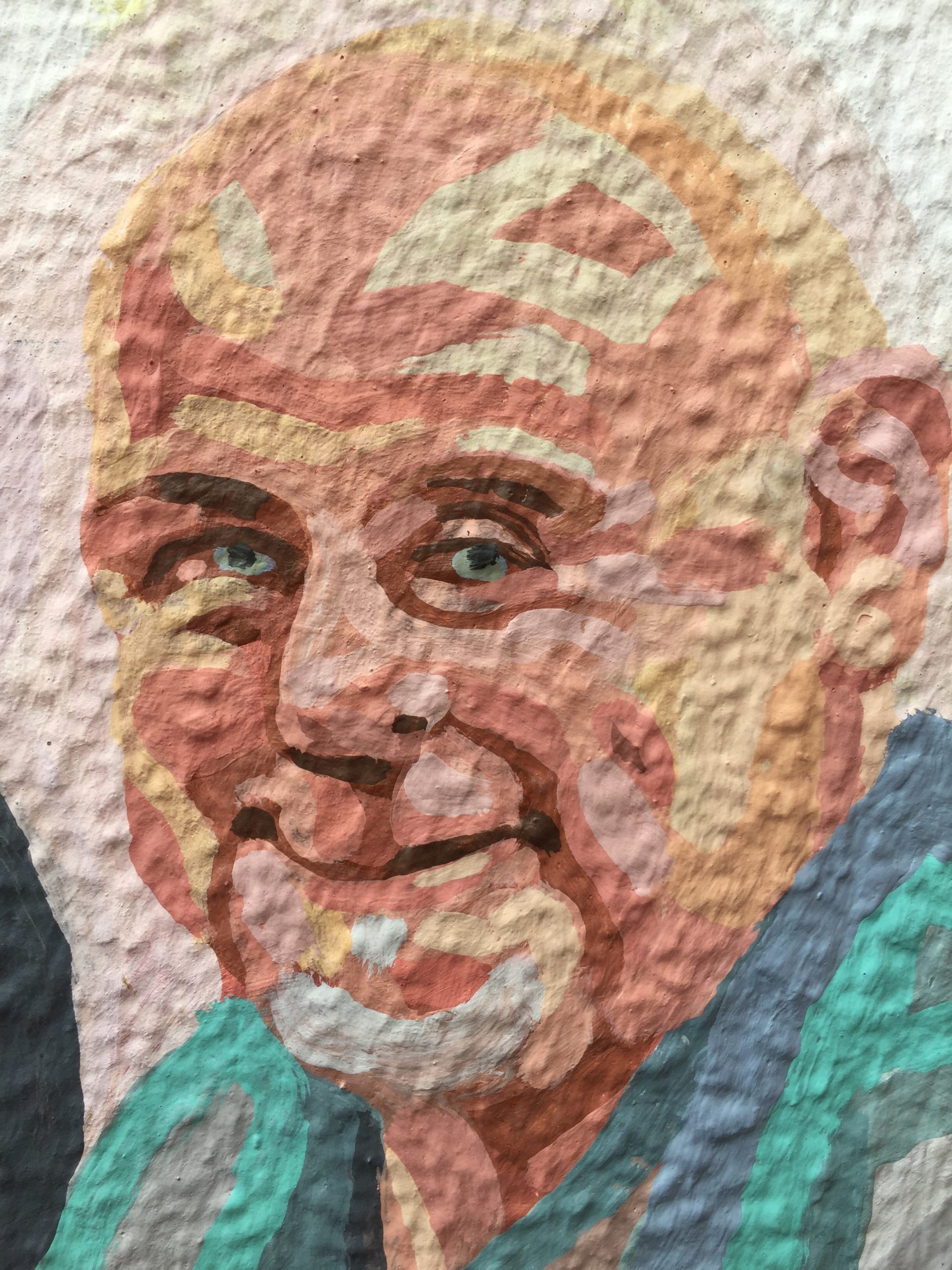

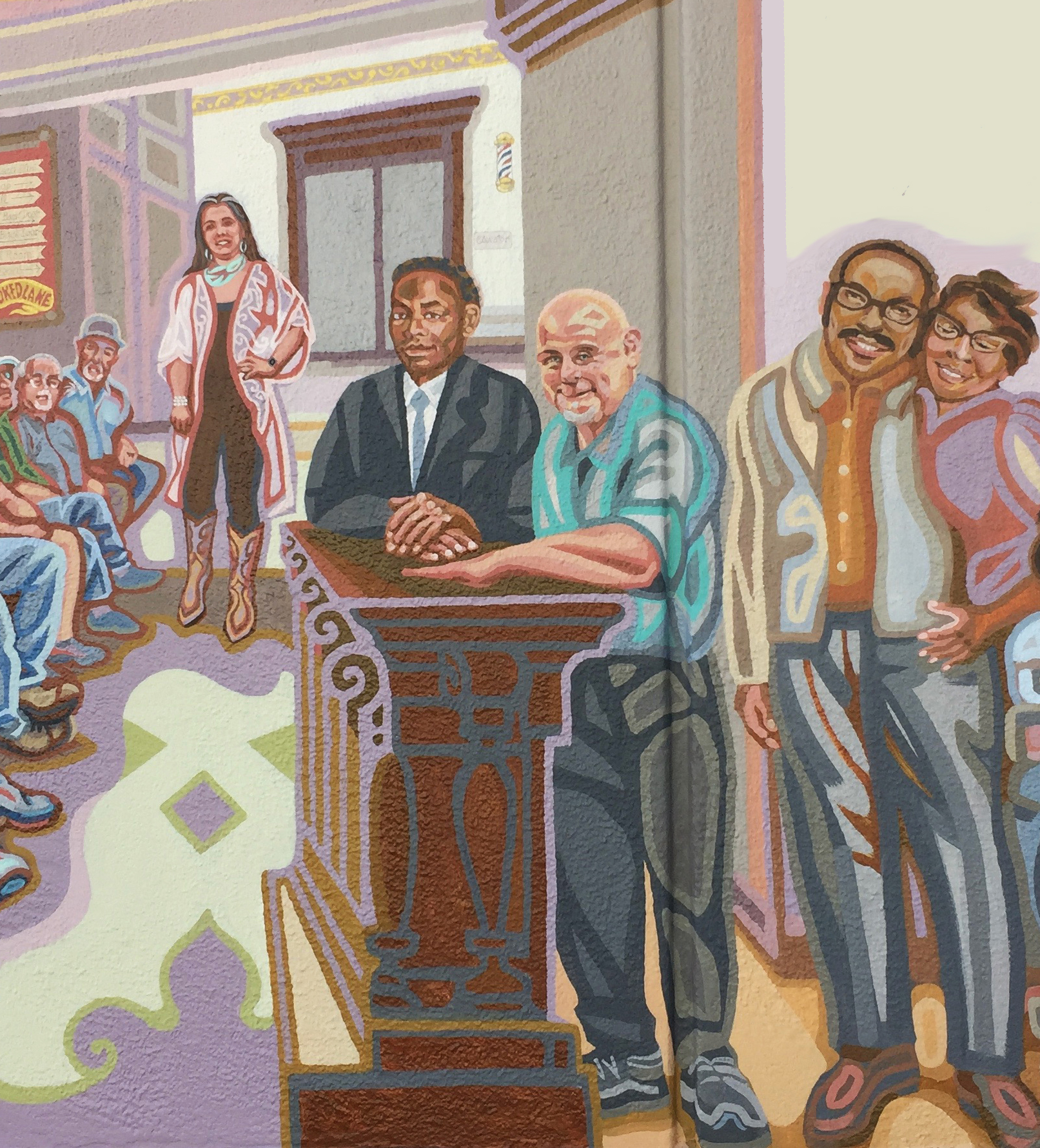
This is a portrait of Harold (Hal) Perry, a distinguished graduate of Ukiah High School, whose family story is one of triumph over mid-century racism and how a small California city found its better self.
The Perrys were from near St. Louis. Verna and Charles met in their church choir. Neither were able to go to college, but yearned to provide the opportunity to their children. At the end of World War II they left the entrenched racial subjugation of an area where the unspoken rule for Blacks was: don’t be out after dark in any white town. They headed to California in search of decent work and good schools. In Bakersfield, education was segregated, so they traveled to Northern California hoping to find an integrated school.
Would they find it?
No. But Ukiah gave them the next best thing.
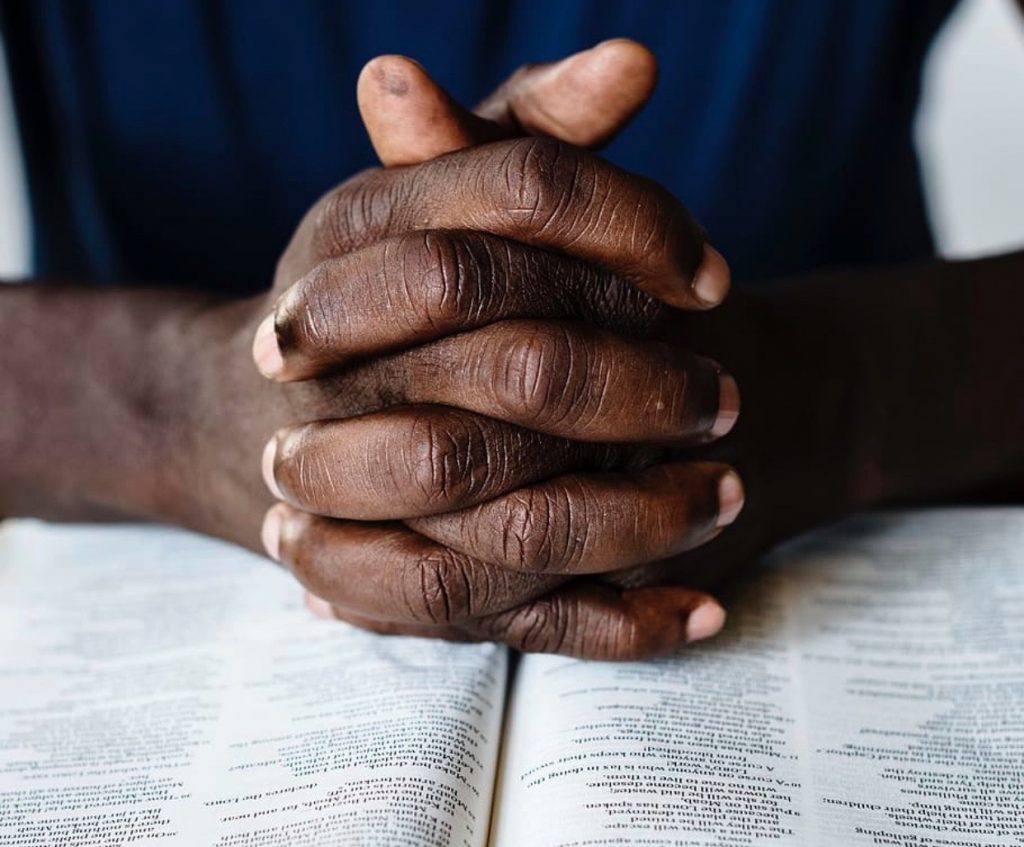
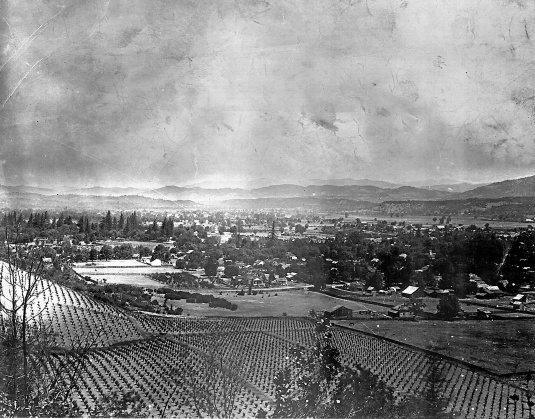
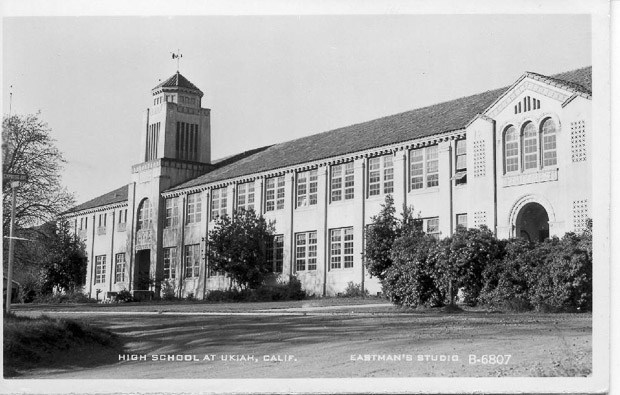
There were no Black children in Ukiah, so there were no segregated Black schools. Charles found work playing jazz at the E&B nightclub and was allowed to rent the little house behind. Immediately, the three younger Perry kids were enrolled in school! Whether planned or not, the move was brilliant.
The kids excelled in their classes and in sports. But trouble loomed. One day, a few “prominent” men of the community came to Charles and told him that his children could no longer be in school. They said Ukiah had never had negro students and wasn’t going to have them now. Charles’ response was non-confrontational so as to avoid a fight, but he also didn’t comply. He called the men’s bluff, and the kids stayed in. Moreover, young Hal, Manuel and Barbara had become well-liked and respected by most of their teachers and peers. Hal was elected class president from the 8th through 12th grade and became a star athlete.
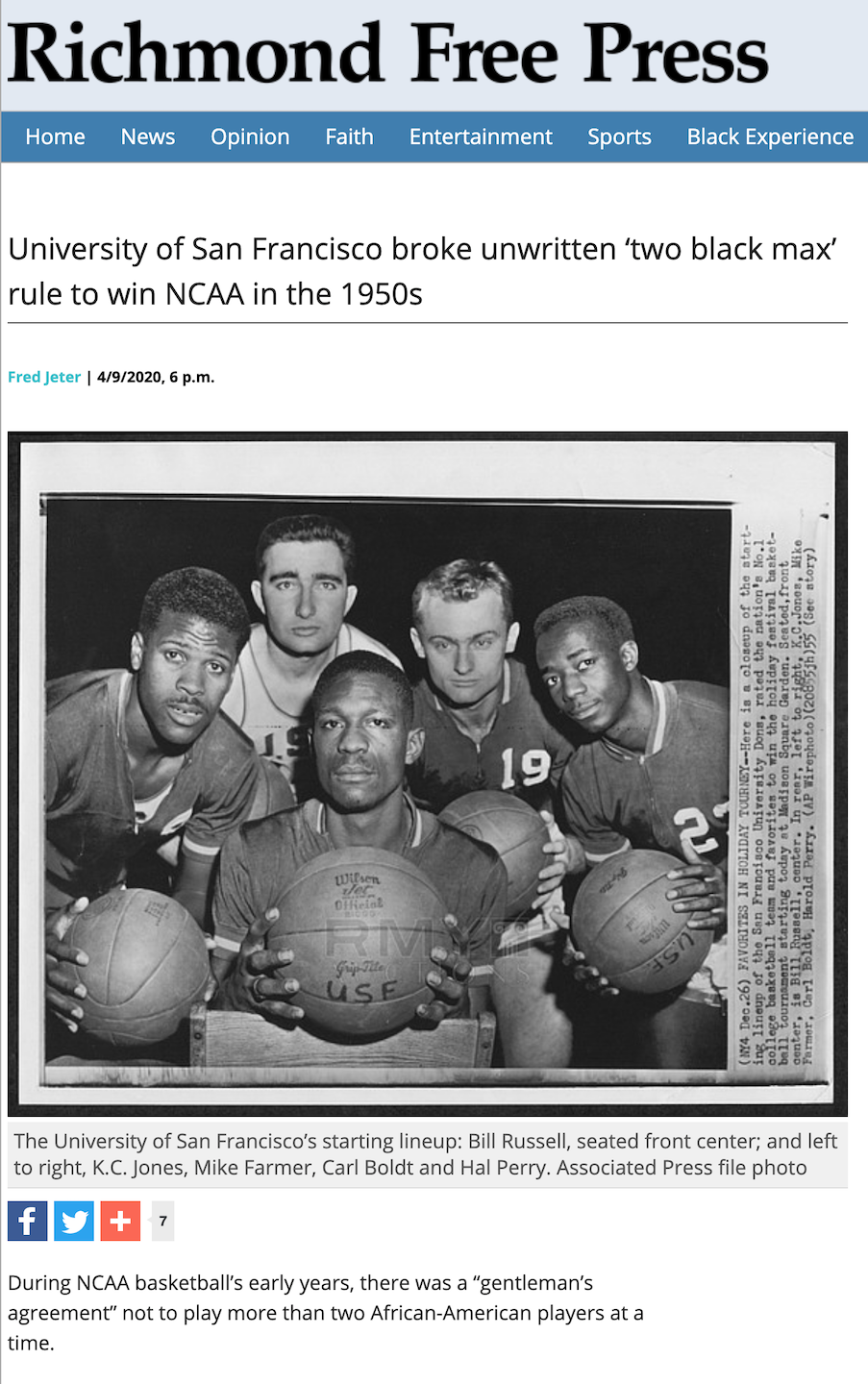
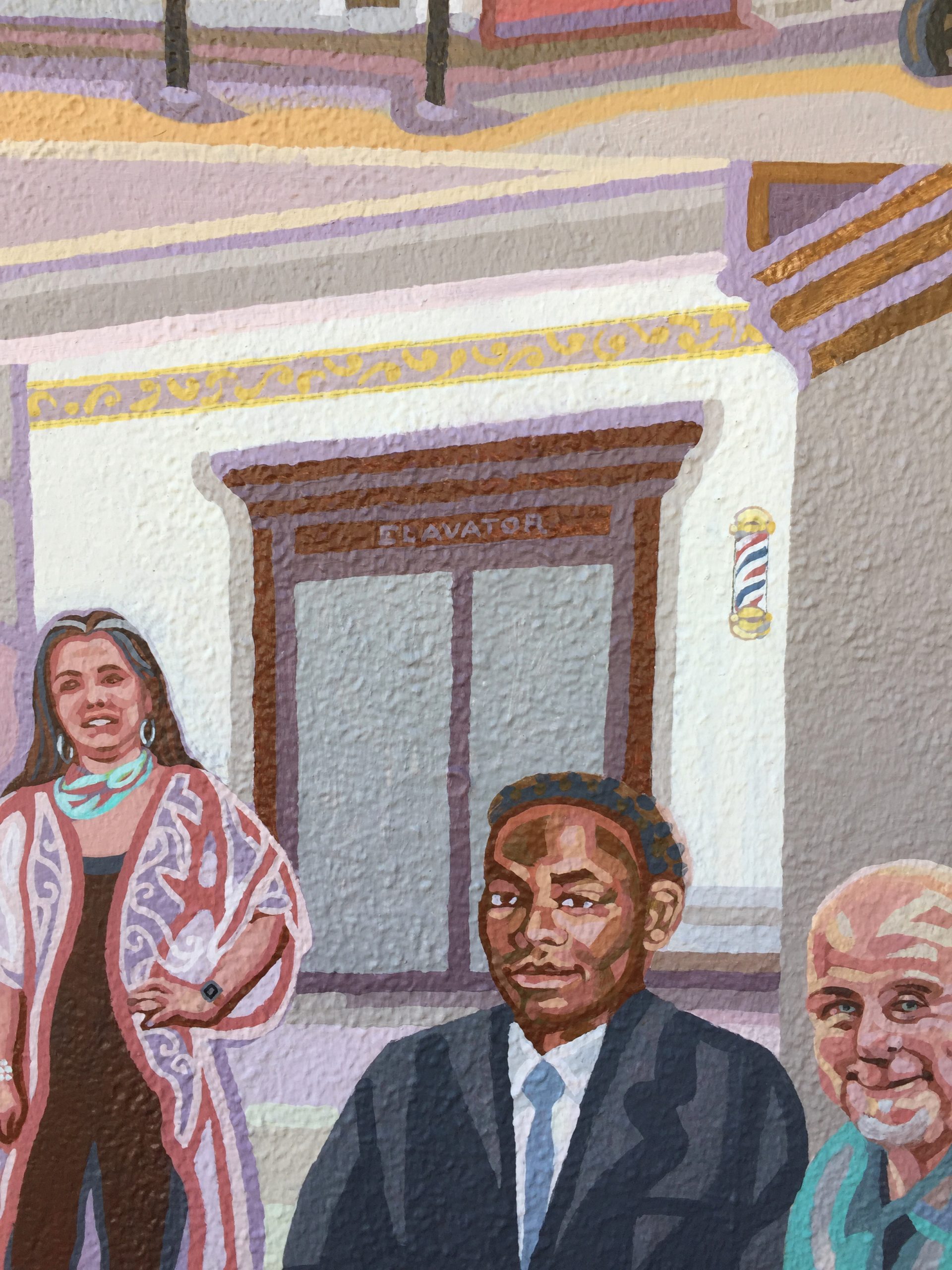

Hal was recruited by the San Francisco Dons, where he played with Bill Russell on the undefeated NCAA National Championship basketball team in 1955 and 1956. This was electrifying for Northern California and Ukiah! It was groundbreaking as well, because the Dons broke the traditional “gentleman’s agreement” not to have more than two Black starters. The Dons had three: Bill Russell, K.C. Jones and Hal Perry.
Hal went on to become a lawyer, dedicating himself to working against oppression. That’s why I painted him in a suit, respected and welcomed in this hotel, not denied entrance as he and his teammates were in Oklahoma, because of their race. In that instance, and others in Ukiah, his team rallied round and they all camped out in a dorm. In the mural, Hal stands inside the same Palace Hotel where his father had to set up a shoeshine stand to make ends meet.
This account and much more can be found in the March 2017 Historical Society of Mendocino County Journal, dedicated entirely to the Perry Family. See also the Richmond Free Press and Harold (Hal) Perry 1933-2009
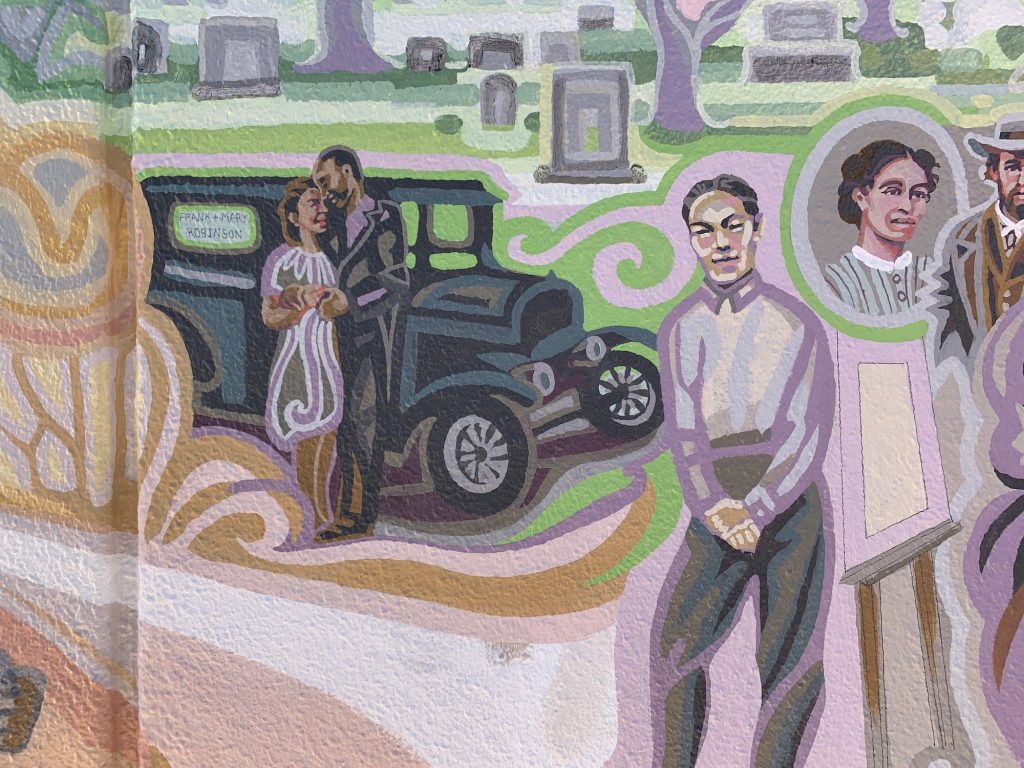
Why did Hal Perry’s dad have to shine shoes in the Palace? Because when those men ordered Charles Perry refused to pull his kids out of school, he was fired from his job in the band and the family was kicked out of the little house behind E&B Club. They were helped by Frank and Mary Robinson, seen next to their beloved Model-T.
The Robinsons were some of the first Black residents here, and their story is one of fun and kindness, rescued from oblivion by one man’s memory. Find it in panel 25 remembrance.
Finally in this scene I painted two iconic Ukiah people, who also illustrate inclusion and community. They are Big John Hill, who worked for many years at the Ukiah Theater and Drive-in, pictured here with his beloved wife Rita; and Martha Lewis, a courageous mother confined to a wheelchair her whole life, who nonetheless raised two beautiful and successful children, Joni and Jim. She was known throughout town for going wherever she needed to go with one or two little kids in tow, riding on her motorized chair.
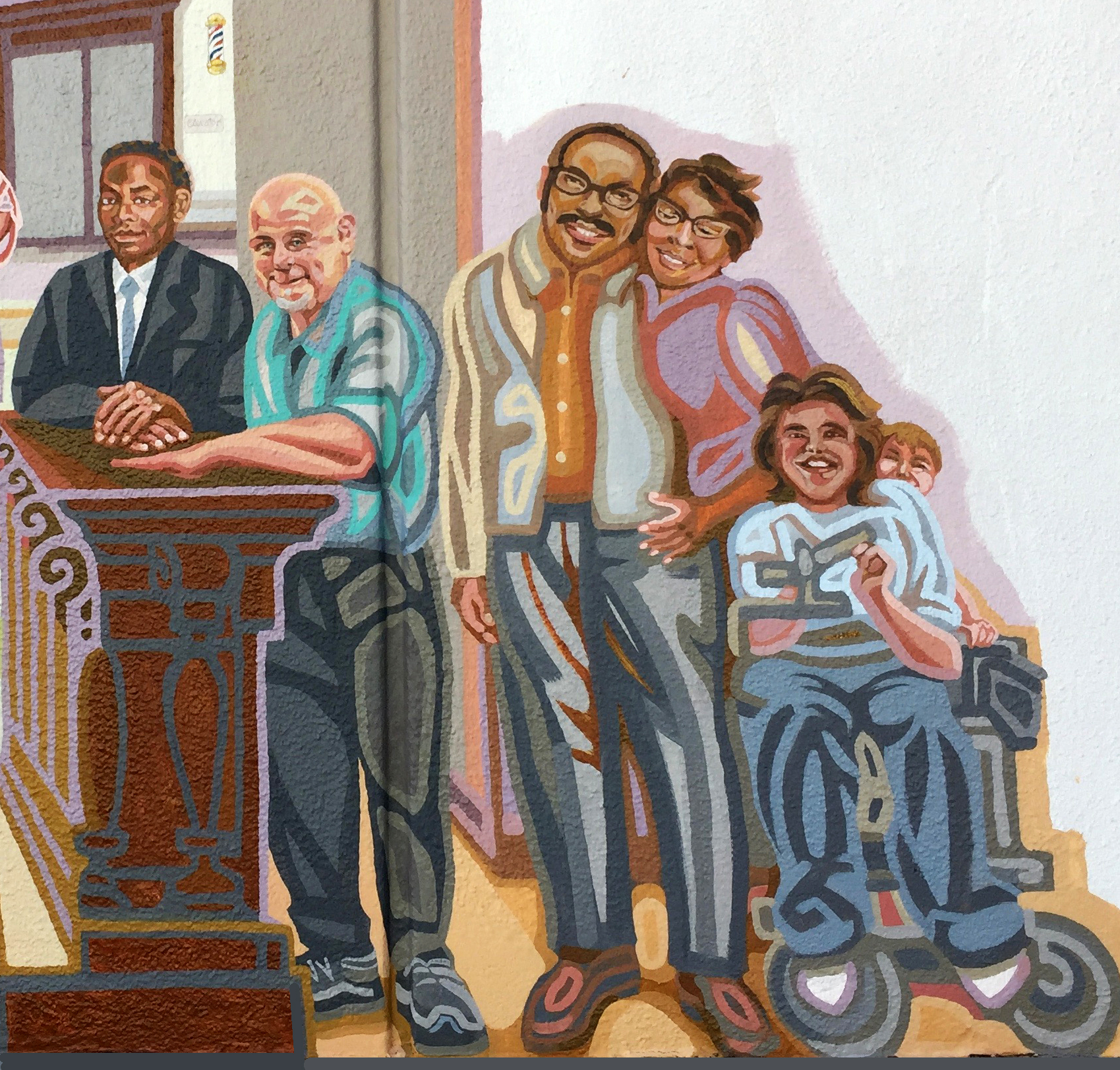
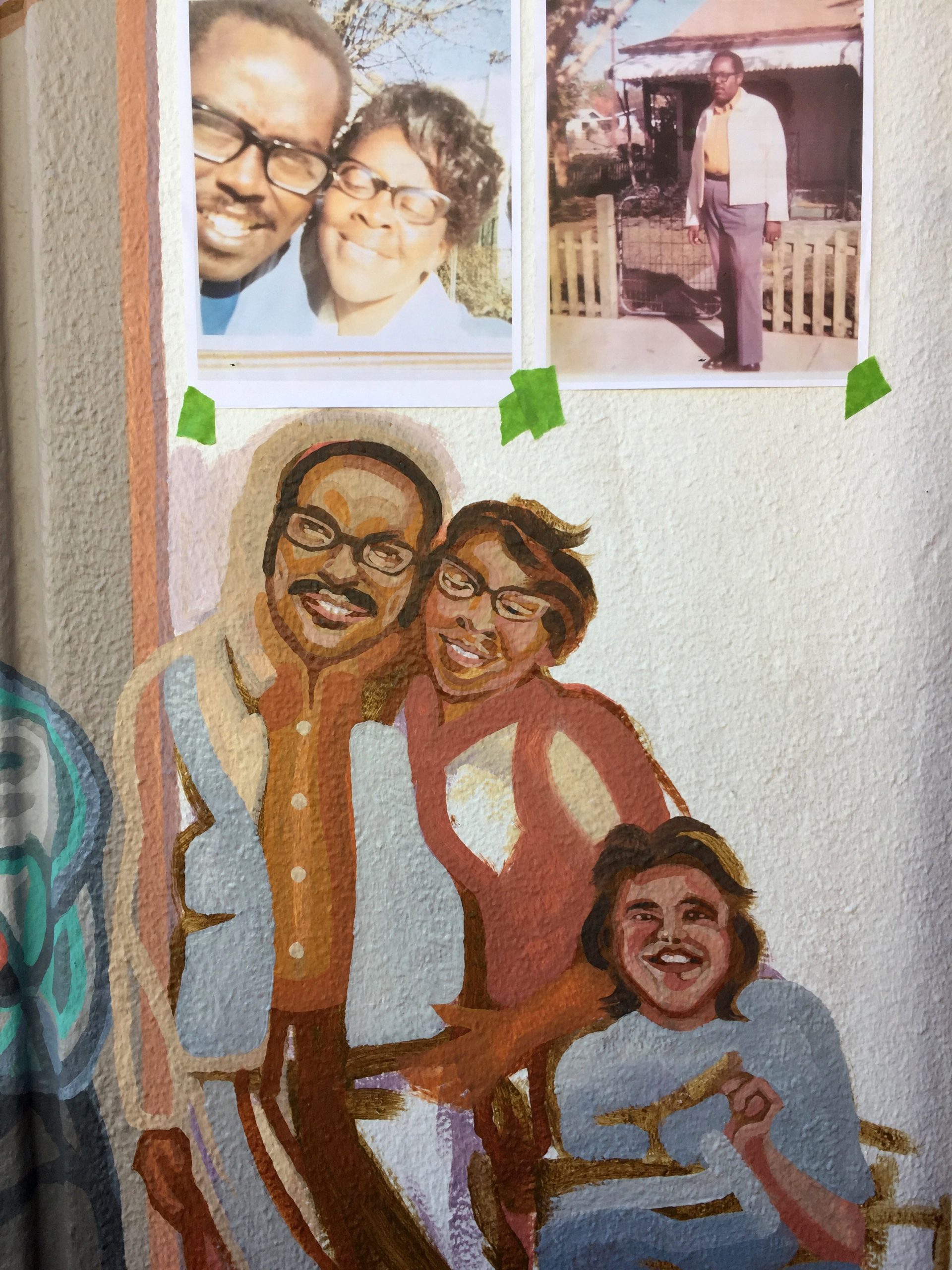
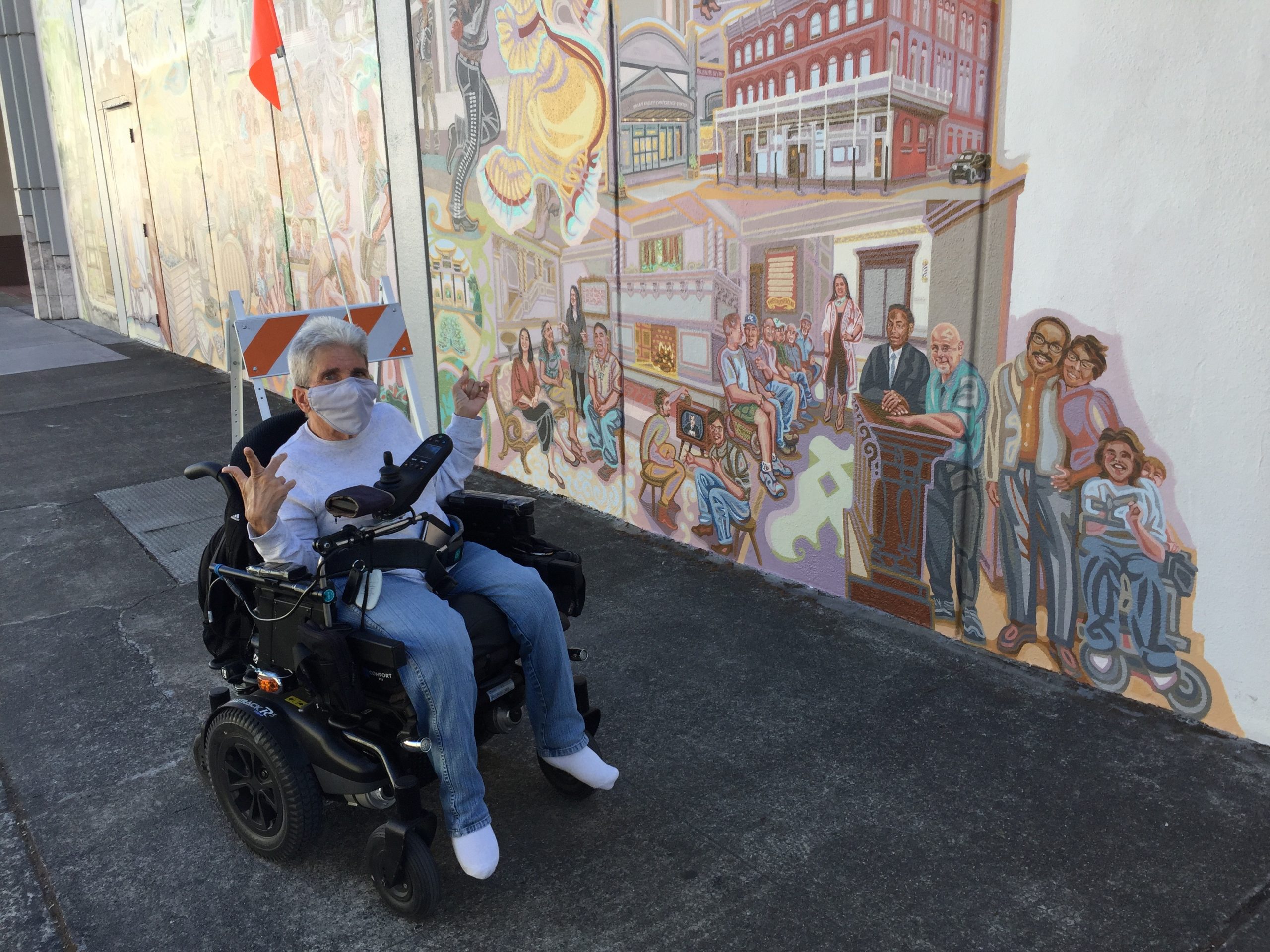
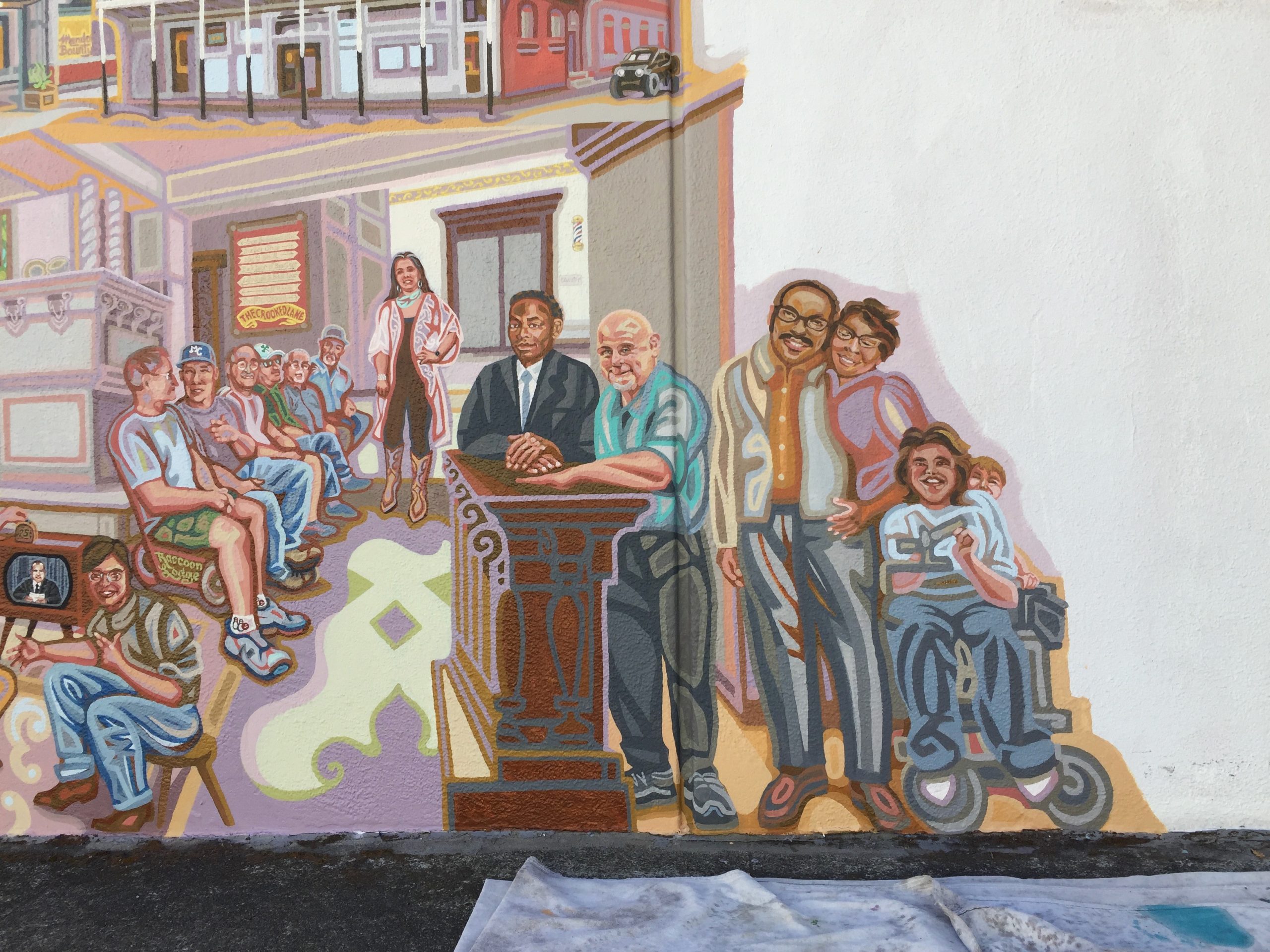
John Hill moved to Ukiah the year Hal Perry graduated, in 1952. He was popular and well known, especially working for the Ukiah Theater, when he would drive around town with a loudspeaker on his car letting people know what movie was playing that night. But woven into his story are strands of racism and discrimination invisible to the casual acquaintance. He told me how no one would rent to his family at first, until Native people on the reservation took them in. The man who hired him at the theater, Mr. Jay Allen was part Native, and virtually adopted him.
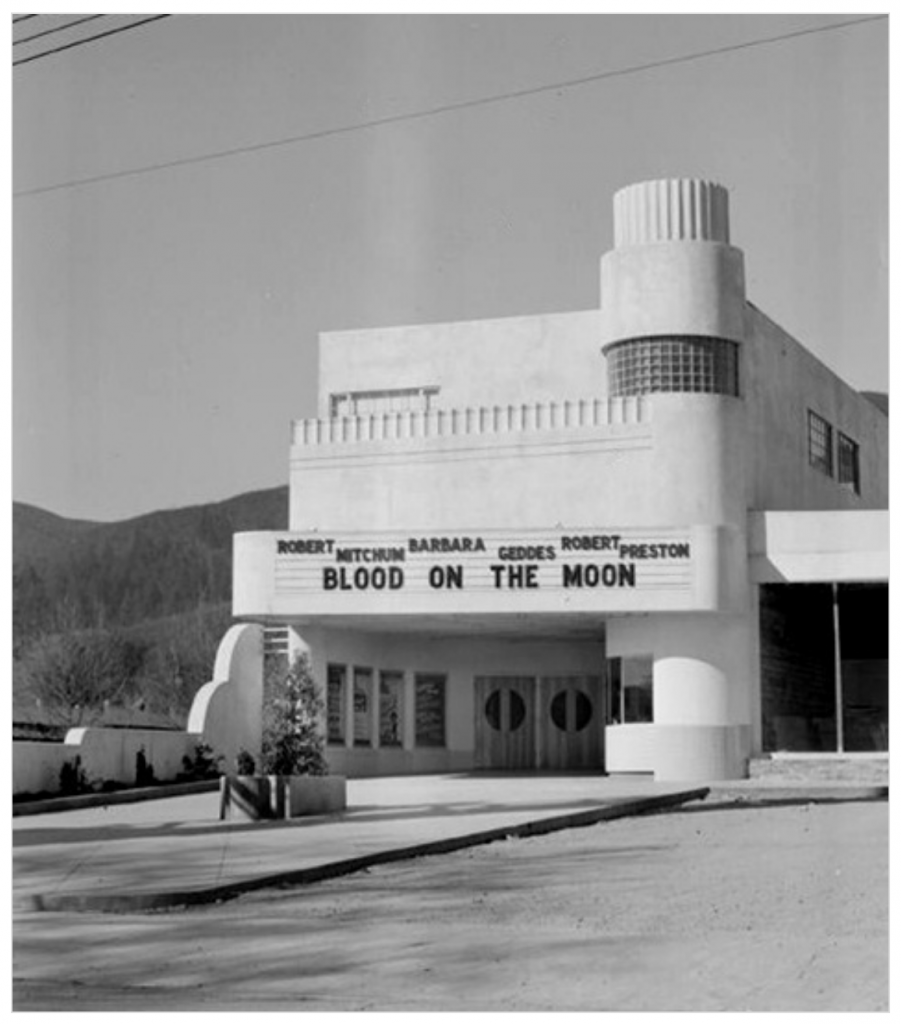
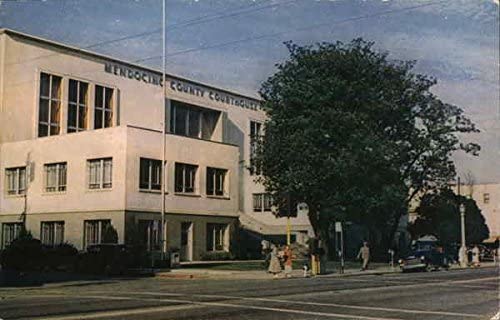
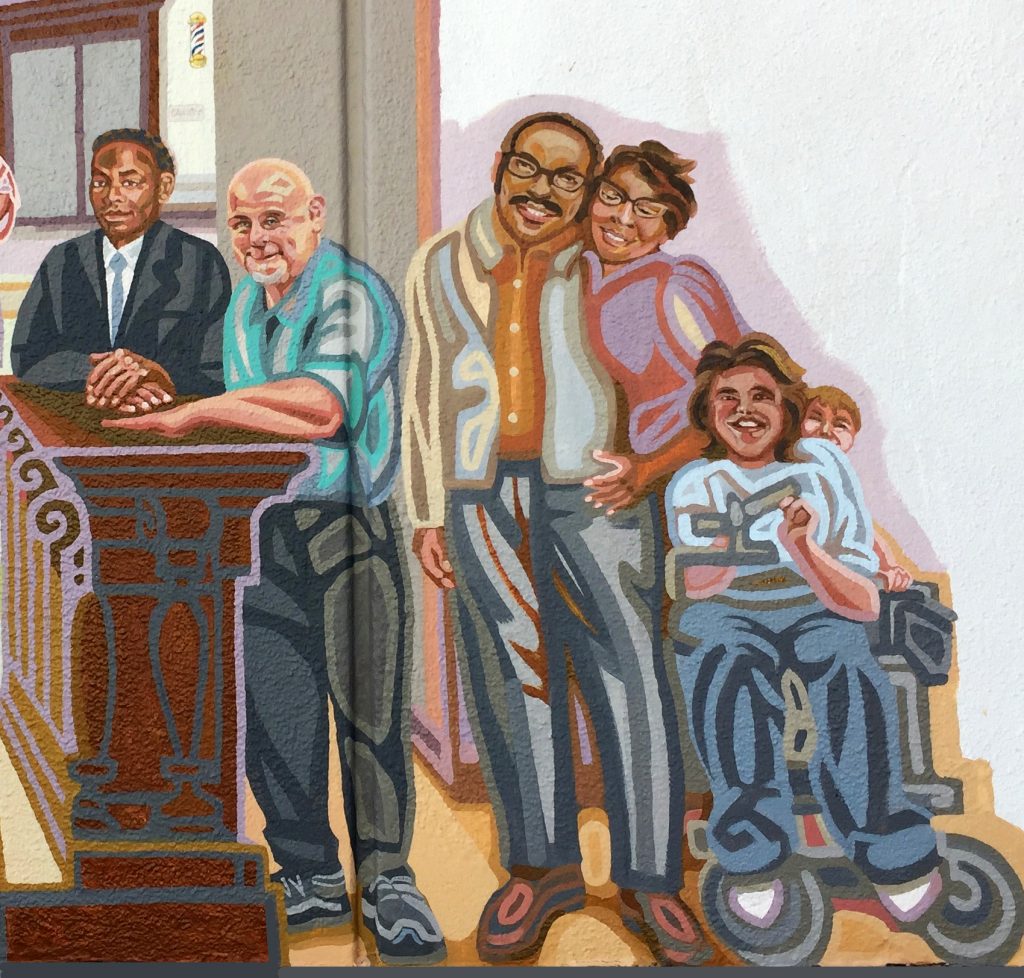
John tried for years to become a Sheriff’s Deputy, but was turned down for training time after time. Finally he was hired at Corrections and given the job of transporting prisoners. “I found another way,” he told me. Once during the ’80s he stepped out of the Courthouse in his uniform with his gun, shocking an out-of-town couple who couldn’t believe what they were seeing.
His story shows the struggles that spring from our past. And it shows how a community can always try to find its better self.
Up next: